I’m sharing our trip to Ireland! We rented a couple of cars and drove from Dublin down and across the country and back, and today we’re sharing some of the amazing things to do in Ireland and how to plan your own trip.


A girls’ trip over 10 days with 2 generations and 2 cars
Back at the end of May and early June I gatecrashed my aunt’s girls’ trip with my cousins and went to Ireland!
The group consisted of my aunt (my dad’s older sister) and her good friend, my cousins Kim and Steph who you may recognize from our trip to Maine, and Kim’s childhood friend.
Together, we embarked on a rather aggressive itinerary over the course of 10 days. Here it is roughly:
- Days 1-2 in Dublin
- Day 3, leave Dublin and drive to Inistioge through the Wicklow Mountains to stay overnight
- Day 4, see the Rock of Cashel and head to Kilkenny
- Day 5, leave Inistioge, drive to Killarney, and stay overnight in Dingle
- Day 6, drive the Ring of Kerry
- Day 7, explore the Dingle peninsula
- Day 8, leave Dingle and head to the Cliffs of Moher and stay overnight in Athenry
- Day 9, see Brú na Bóinne and drive back towards Dublin airport to stay overnight
- Day 10, fly out of Dublin

Truthfully, I think this itinerary would have been perfect over 14 days instead of 10 to give more breathing room and relaxation time.
I would’ve spent more time particularly in the Wicklow Mountains and in Dingle, which everyone loved because it was so peaceful by the seaside.
But we did cover a lot of ground and saw some really amazing castles, wildlife (lots and lots of sheep and cows), and historical and cultural sites!



First I’ll walk you through the trip, then you can scroll towards the bottom of the post to see my travel tips on getting around, saving travel time, what to pack, and of course, food to eat!
Avoiding a faux pas…
Keep in mind that we’re talking about the Republic of Ireland, not including Northern Ireland which is one of the constituent countries of the United Kingdom.
There’s a significant amount of history there (Derry Girls scratches the surface) which is still playing out today. One important difference for American tourists to keep in mind is that Northern Ireland uses British pound sterling, and the Republic of Ireland uses euros. It was interesting to learn about Irish history while planning this trip.
Here are a couple common questions you may have when it comes to Irish culture—and answers!
Should I call the native language Irish or Gaelic?
“Irish” is the correct answer if you’re speaking English, whereas Gaelic is an adjective to describe the culture and the people of Ireland.
Though Gaelic is derived from the Irish word “Gaelige,” which is the Irish word for the Irish language. Confused yet?
What about “celtic”?
Celtic is used to describe ancient groups of people across the region and slightly beyond. Celtic ancestry applies to people spanning the Black Sea to the British Isles and Ireland and to people from the North-Western part of Germany to the Northern part of Italy. Highland Scots, Bretons, Cornish, and Welsh folks are considered Celtic.
Things to do in Ireland: Where we went and what we did
Dublin
After a flight delay and a rough red-eye, we took it easy when we touched down in Dublin the next morning.
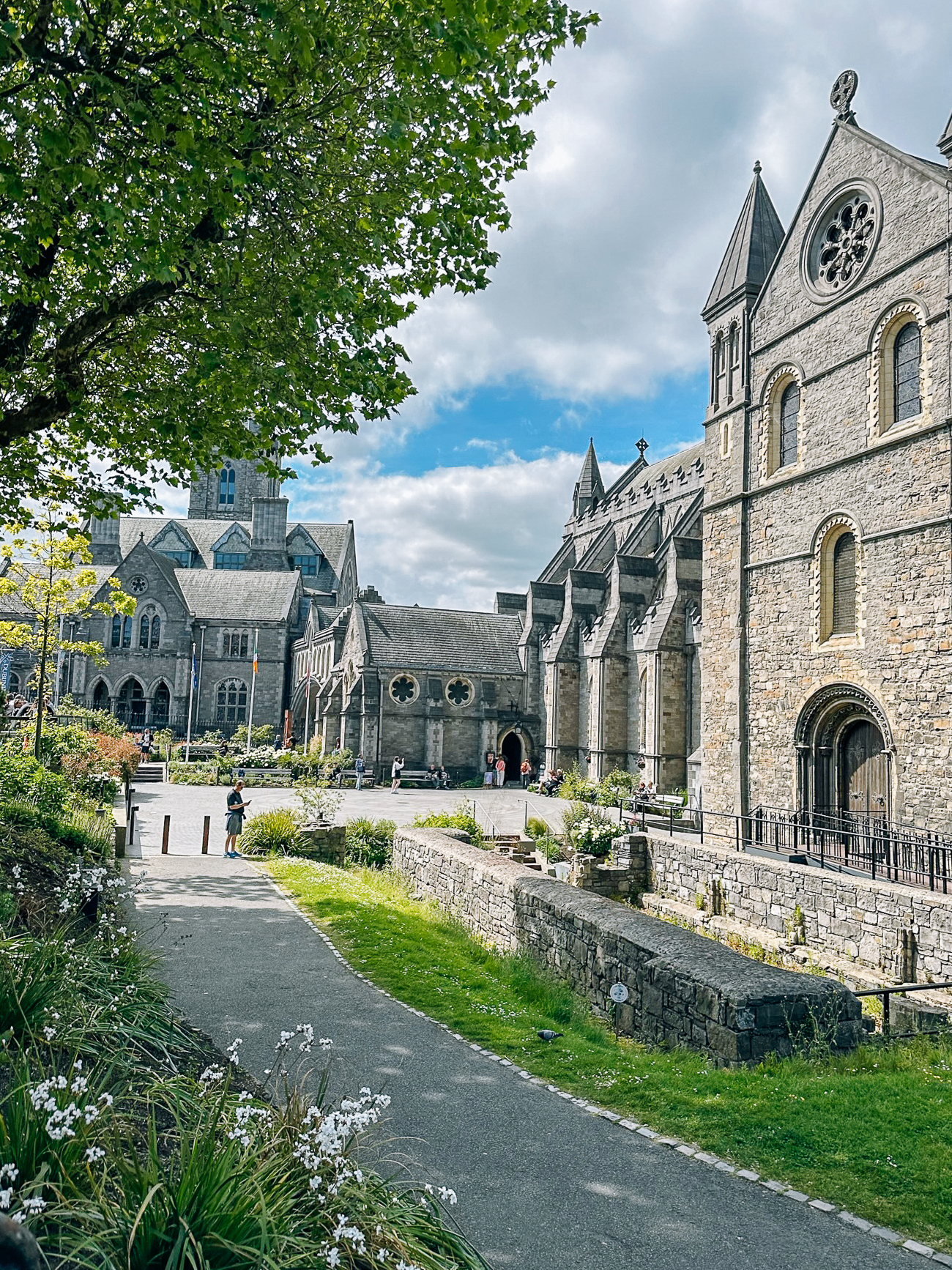

Guinness Storehouse
We knew that we wouldn’t have energy for much, so we headed to the Guinness Storehouse. This is one of the top tourist attractions in Dublin. Apparently, the Guinness tastes different in Ireland.


Your ticket comes with a drink at the Gravity Bar, where you can see a 360° view of the city. The exhibition hall had 7 or 8 floors, each one unpacking a part of the brewing process. My impression was that the space was designed to hold a lot of people, but they didn’t go into too much detail.




There was also a section on past advertising campaigns, and a shop with merch galore for Guinness enthusiasts back home.
Trinity College / Book of Kells
The Book of Kells is a Bible manuscript famous for its ornate Celtic illustrations. It dates back to 800 AD and is a unique example of Celtic illustration, housed in one of Trinity College’s oldest libraries.


You can also see the Brian Boru harp, also known as the Trinity College harp, which is a national symbol of Ireland. (You probably recognize it from the Guinness logo too!)

If you’d like to see it, book tickets in advance! The day sells out quickly!
St. Stephen’s Green
Our hotel wasn’t far from St. Stephen’s Green, so it made for a perfect, peaceful morning walk for the early risers among our group! It was full of birdsong and flowers. You can also see a monument to James Joyce there.

Something to keep in mind is that Dublin is NOT an early rising city. Not even the churches open earlier than about 9am, and you’re lucky to find cafes open at 8 or 8:30am. There were maybe one or two places open at 6:30 or 7am when our cousins touched down before everyone else in the early morning.
On the weekends, this is a popular spot to lay out a picnic blanket and relax in the sun.
St. Patrick’s Park and Cathedral
On a morning walk, we also wandered by St. Patrick’s Cathedral.


There’s a lovely little park there that you can walk through with a Viking-themed children’s playground!!
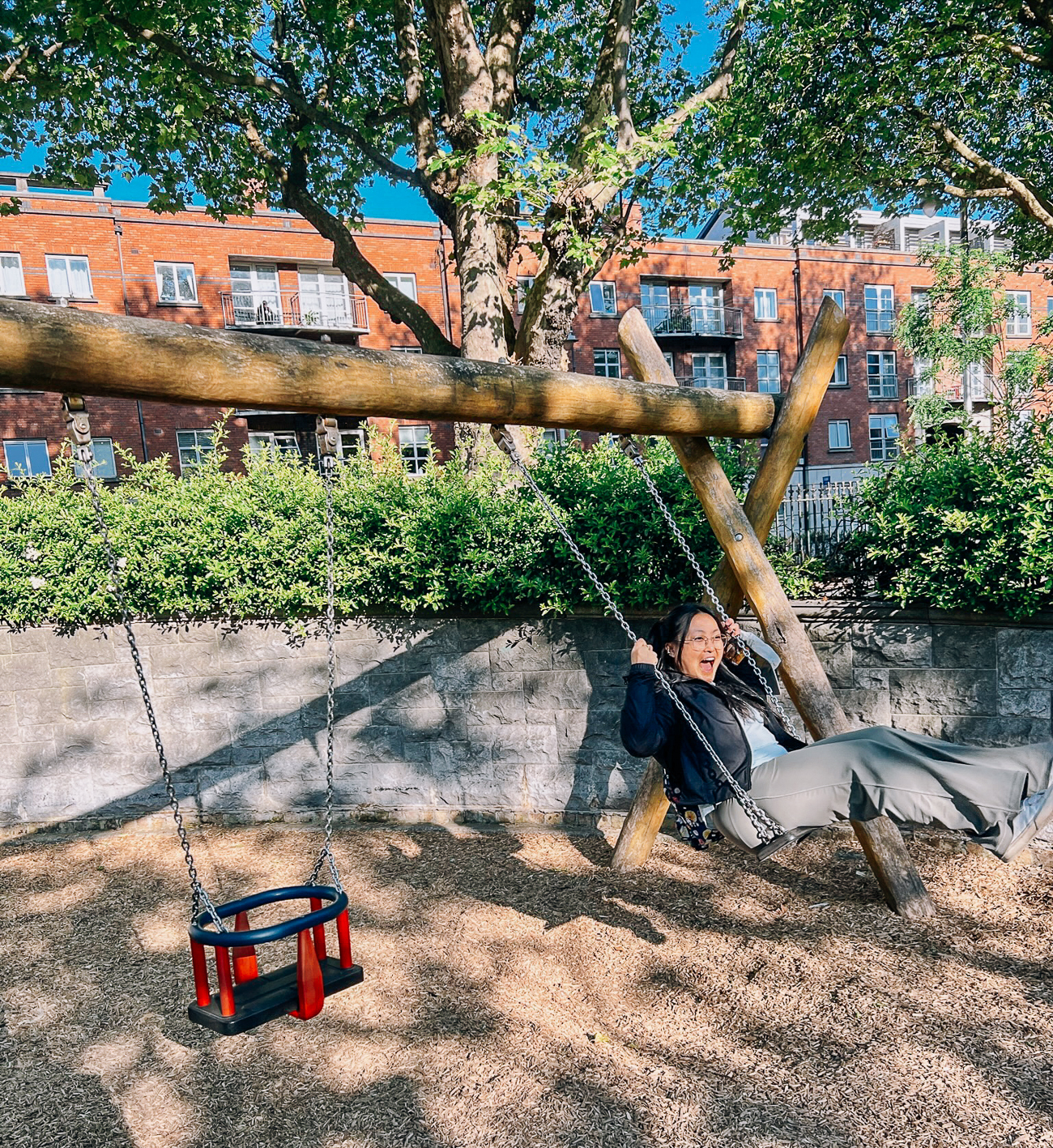

Hop On / Hop Off
Early on in the trip, we started affectionately referring to my aunt and her friend as “the old biddies,” and the younger of the group as the “young biddies.”
With so many of us in the mix, we got tickets for a Hop On / Hop Off bus tour to get around the city and see all the major tourist sights. It’s a good way to see smaller points of interest like the Molly Malone statue, and travel to more notable ones like the Guinness storehouse tour and various museums and distilleries.
It’s an easy and safe way to get around, but you could probably just as easily take a regular bus. Just make sure you hop on the right one, as there are a few companies and some of the logos and signs look very similar!
Ha’penny bridge
This bridge earned its name because there used to be a half penny toll to cross!

National Museum of Ireland – Archaeology
There were lots of museums in Dublin, but we prioritized the archaeology museum. They had a fascinating exhibit (albeit a bit spooky) on the bog people, perfectly preserved in peat bogs.


Temple Bar
Temple Bar is one of the liveliest neighborhoods in Dublin. There are plenty of bars and restaurants.


On a Friday night, it could get a big crowded, so we had a quiet drink at Clarence House, which is owned by Bono. It was a nice quiet hotel bar to have a drink and rest our feet after a long day of sightseeing!
Grafton Street
Grafton Street is a shopping destination and a picturesque spot for a stroll. Here, you’ll find popular global and European brands. You can get lost in Brown Thomas, a luxury department store, window shop, or grab brunch at Bewley’s.

We got some good tips from a couple of store associates about where to find beautiful Irish gifts like sweaters, wool blankets, and jewelry. They recommended Kilkenny Design Centre, which has an outpost in Dublin, as well as Kilkenny (the city) of course!



Leaving Dublin, Driving to Inistioge through the Wicklow Mountains…
We left Dublin just as the hen parties of Europe and the U.K., as well as American college students descended on Dublin looking to have a good time and ingest copious amounts of drink.
We got our rental cars and hopped on the road—an adventure in and of itself. (Read more about it below where I provide more tips on getting around.)


Powerscourt House & Gardens
Personally, Powerscourt Estate was a highlight of the trip for me. It wasn’t too far outside of Dublin, and we unexpectedly spent most of the day there!
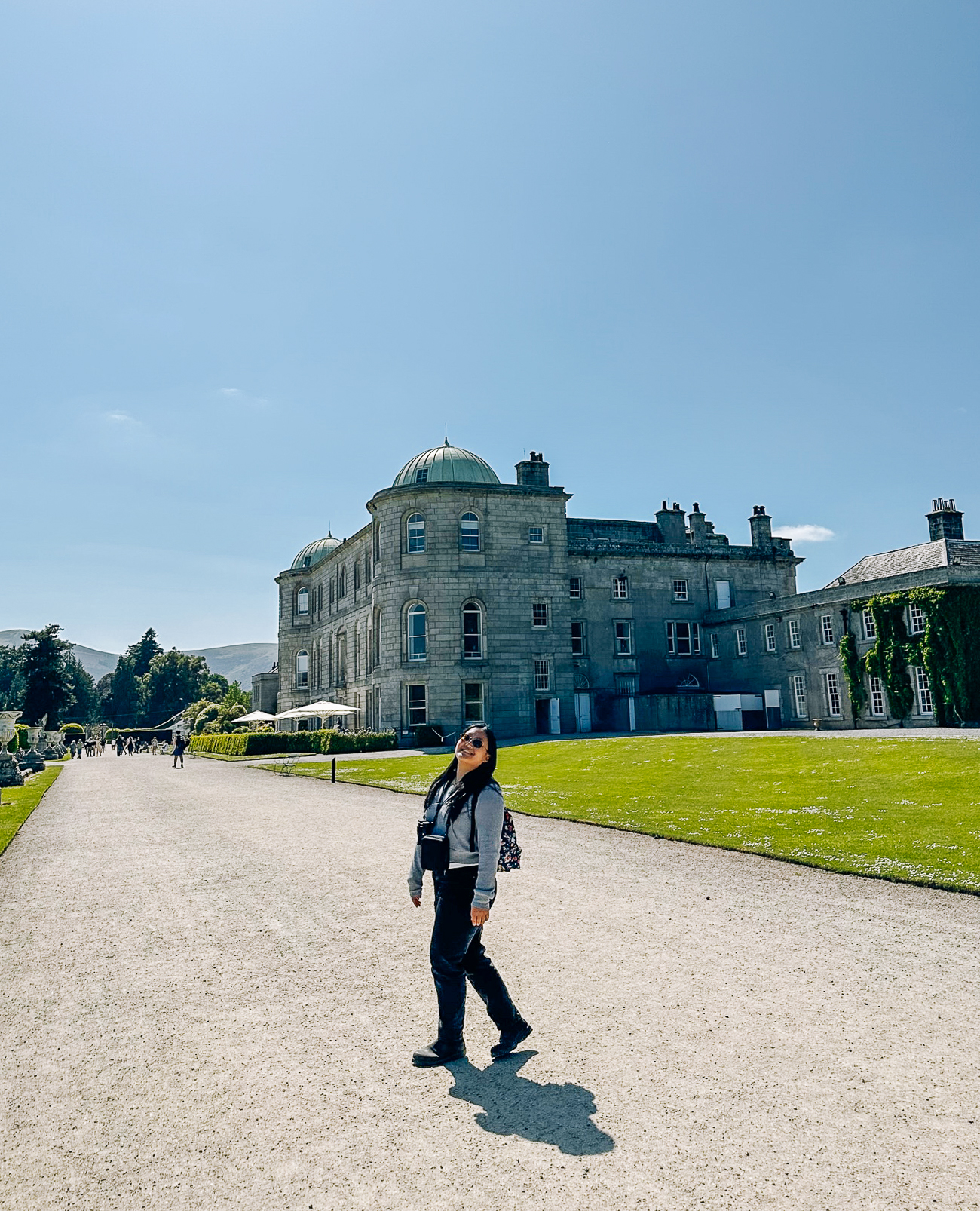

The former home of the Viscount Powerscourt, the grounds are vast and the gardens are perfectly manicured. You can drop off anyone uninterested in the gardens off at the golf course.
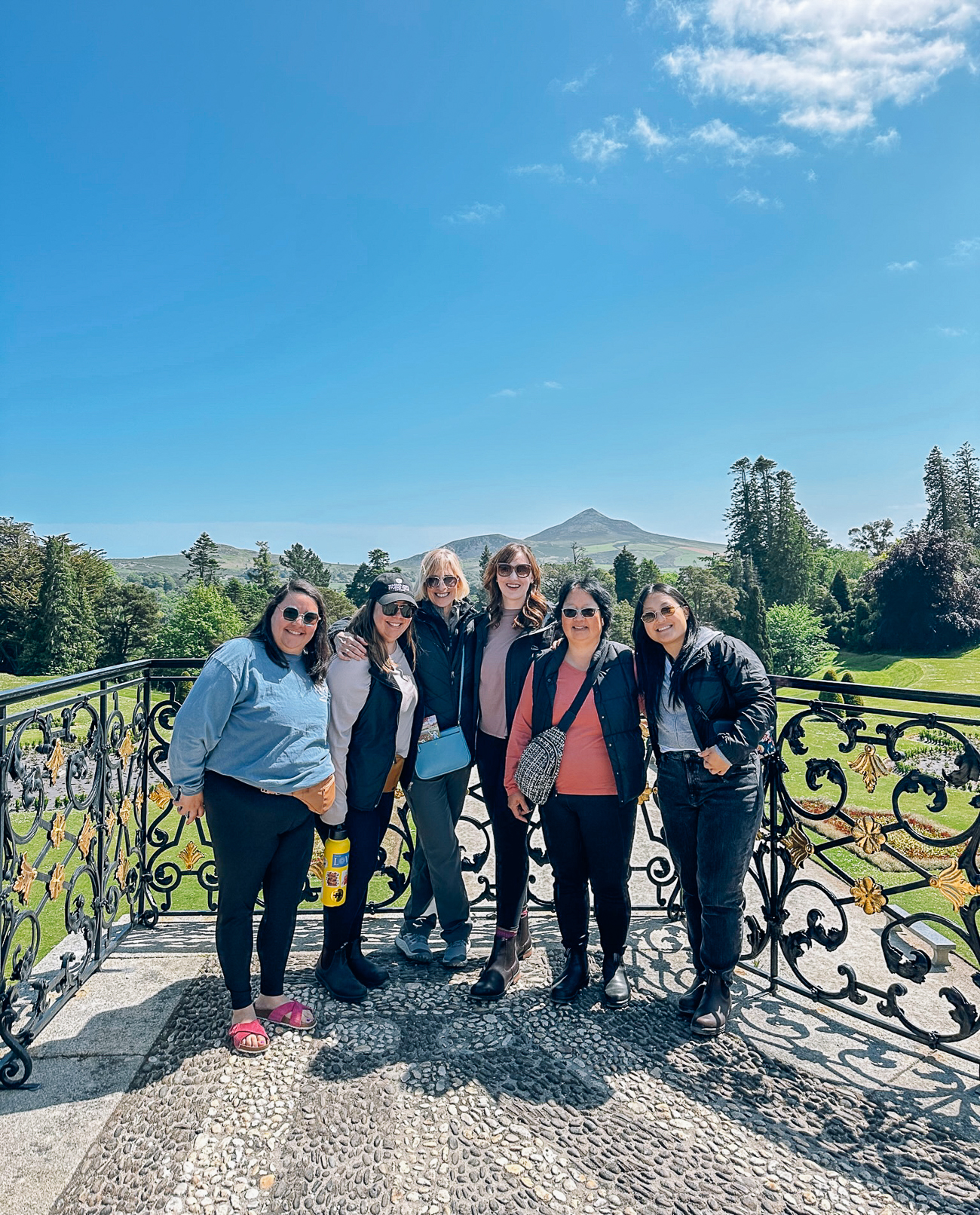



The Japanese garden was a huge highlight, as were the old growth trees. There was lots to explore and a new plant to pique your interest around every corner!
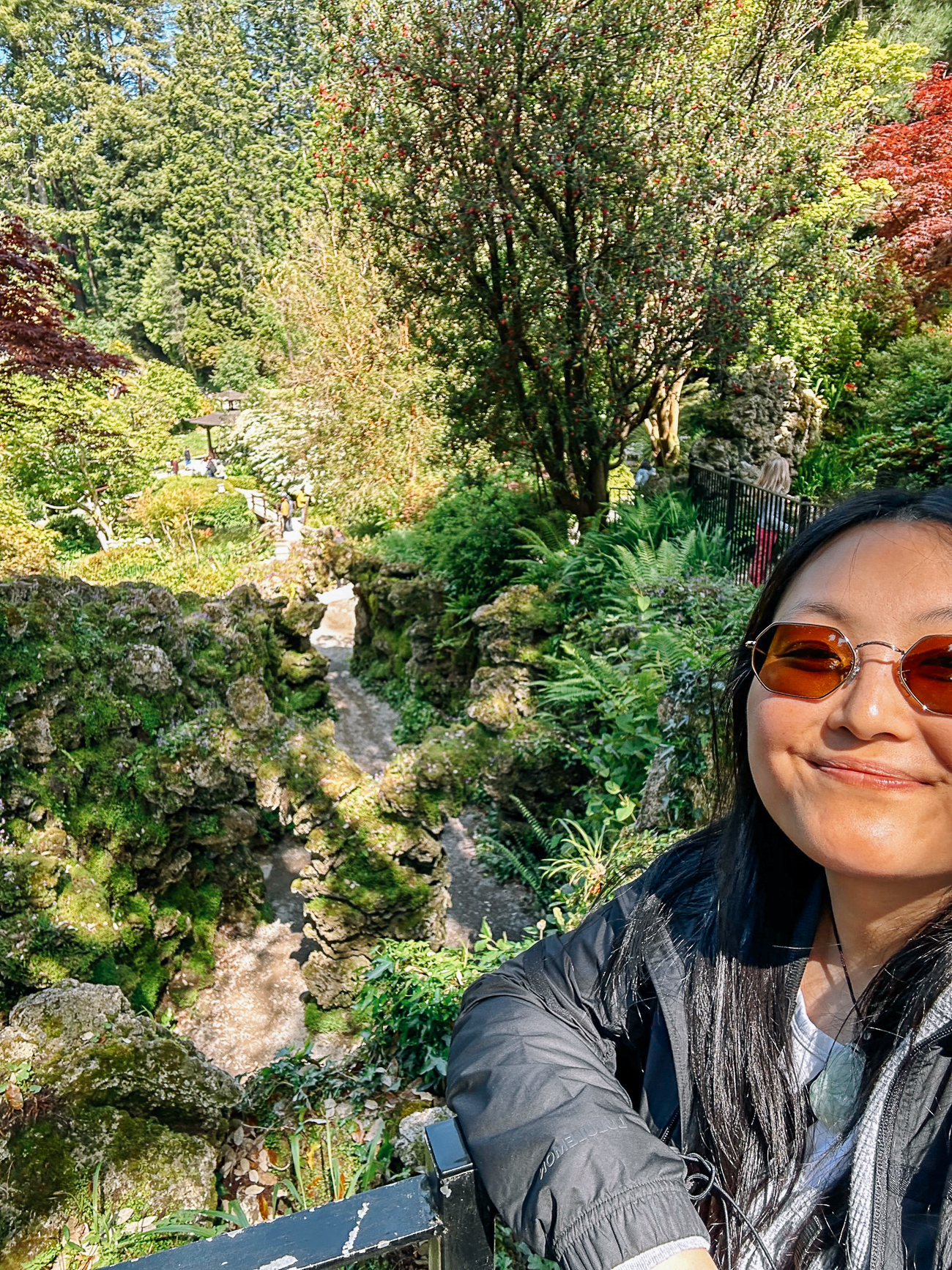


There were loads of nooks and crannies to investigate—even a pet cemetery which sounds macabre, but was surprisingly beautiful and very poignant!
On the bottom right is a grave for a prize jersey cow and an Aberdeen angus cow named Eugenie and Princess, respectively. On the left is a dog named Sting. (“Faithful beyond human fidelity” :’)



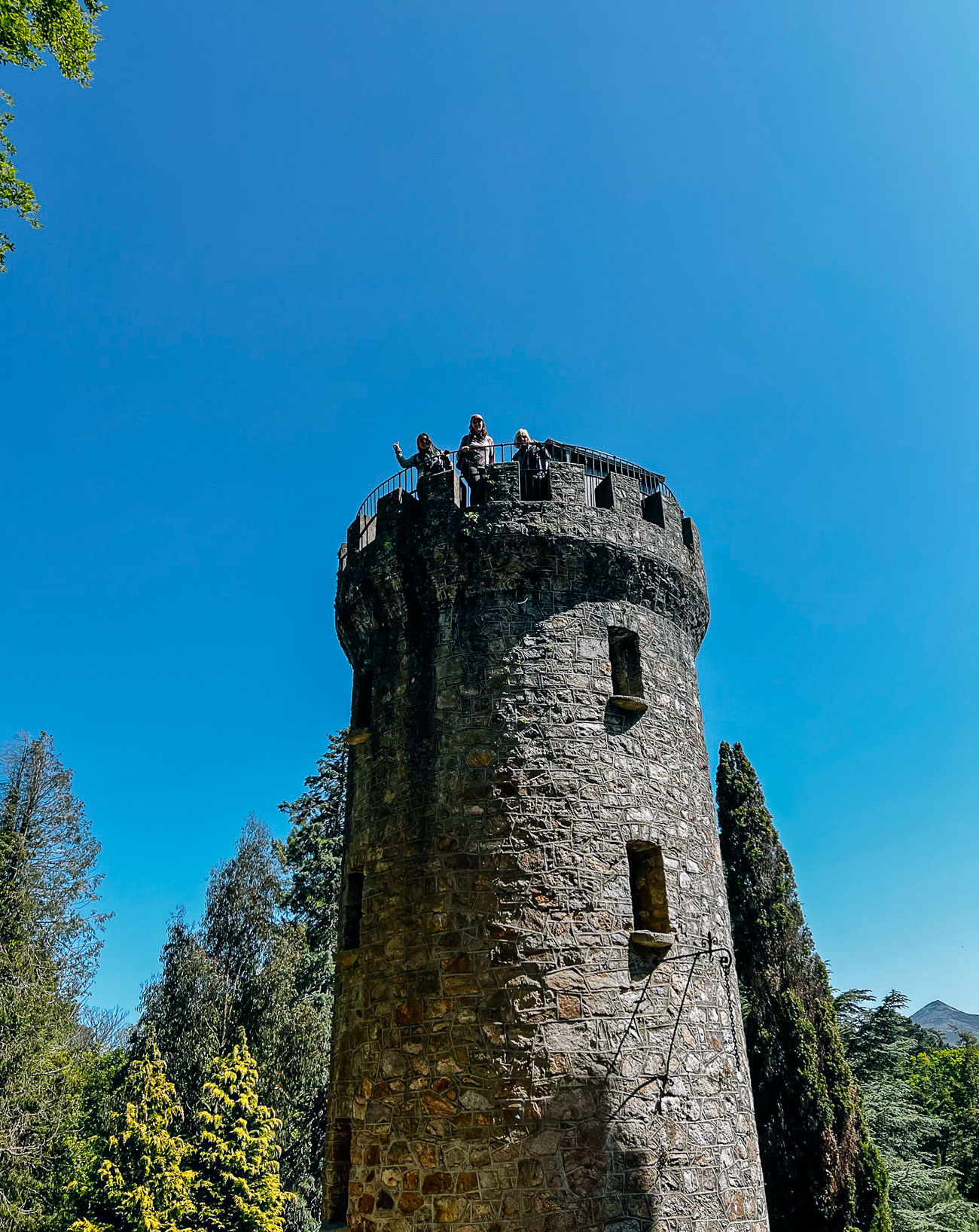
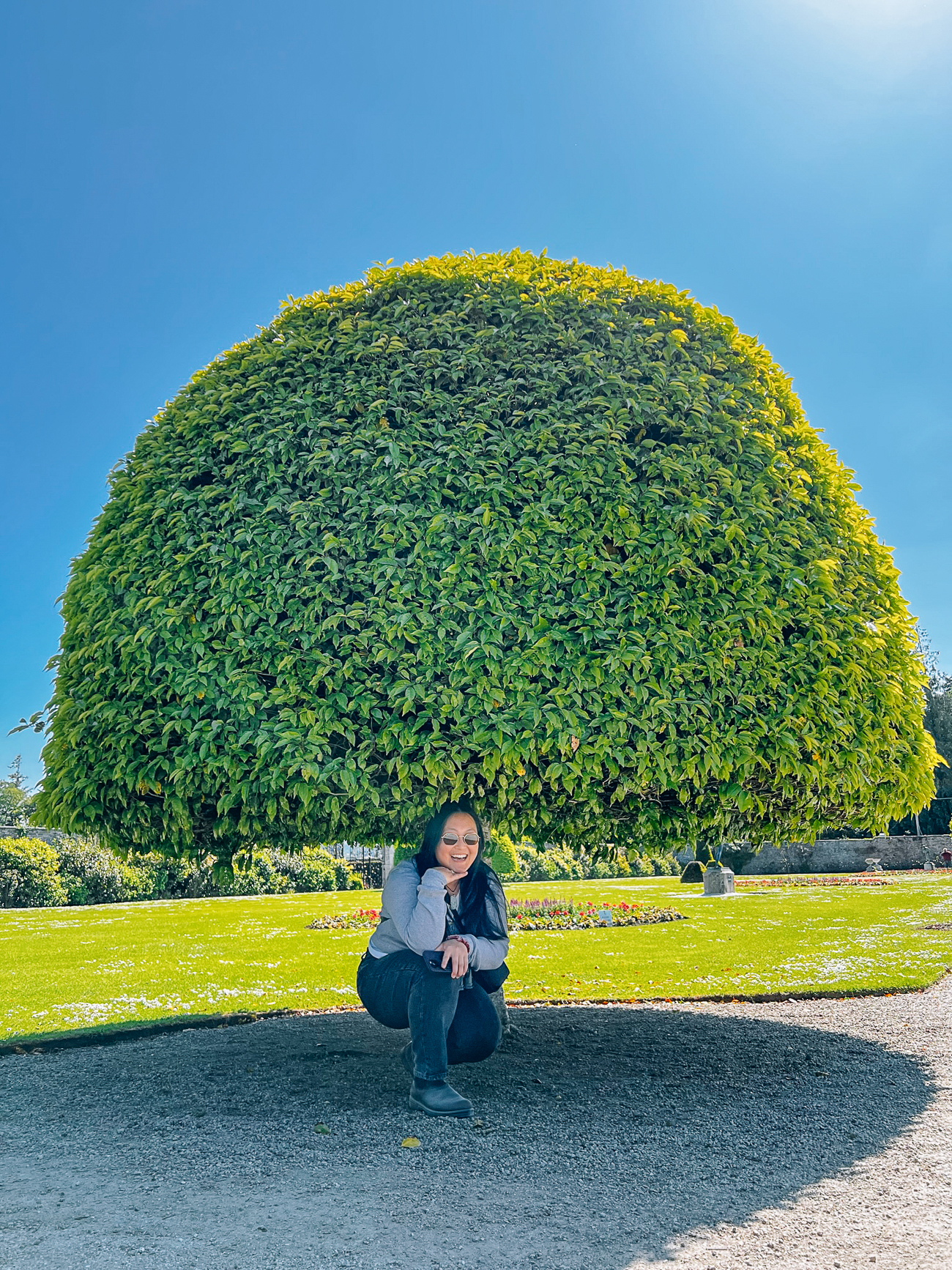
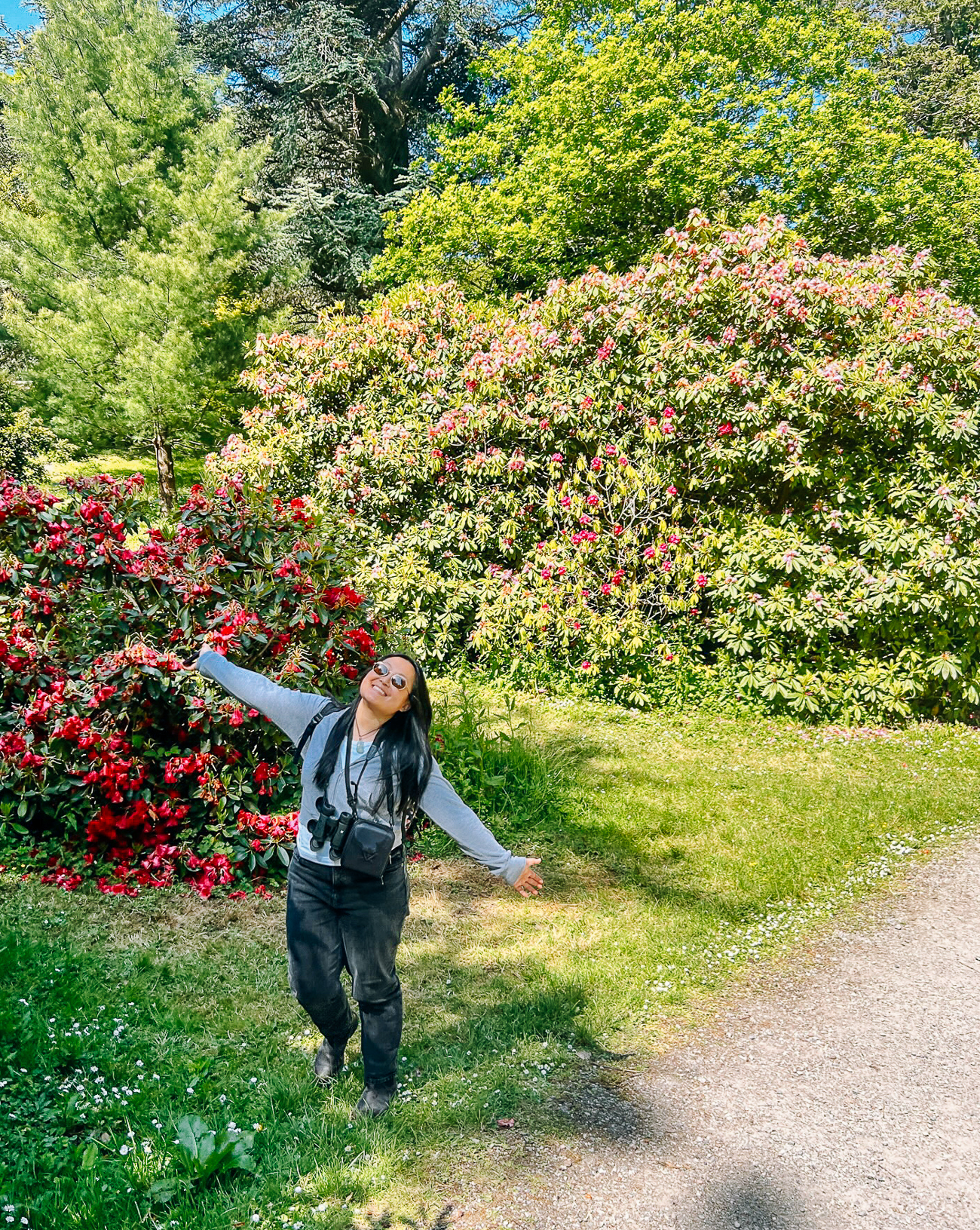



While the house isn’t designed to be toured for its history, there is a cafe serving up delicious wholesome lunch options, and a small maze of boutiques with Anthropologie-esque wares and local crafts.




They also have a nursery where you can purchase plants, though of course that’s more for locals than tourists.



Glendalough Visitors Center
Glendalough is a valley in County Wicklow with a monastery and visitor’s center. It takes about an hour to an hour and a half to visit, but unfortunately we didn’t make it in time after Powerscourt.


The scenery was beautiful and we took a look around before heading out.
Wicklow Mountains scenic drive
To get to our Vrbo house rental, we drove through the Wicklow Mountains National Park. We stopped to admire some of the stunning views and a beautiful creek.








If given the chance, I would have stayed in the area for a few nights to just explore the national park and do some hikes! There’s always next time.
That night we checked into our Vrbo, a former mill house. It was high on charm, but beware. The older and more storied the property, the more likely the plumbing will be a little bit wonky, especially if you have a big group and are traveling during tourist season!






Rock of Cashel
From our Vrbo, there was a long drive to the Rock of Cashel, a medieval castle. This was our first time really experiencing narrow winding local roads. Plus we encountered our first sheep traffic jam! Which was less inconvenience and more delight, admittedly.


You’ll want to book tickets in advance, as the tours fill up quickly. Parking was also a little bit tricky, so the earlier you can get there, the better!
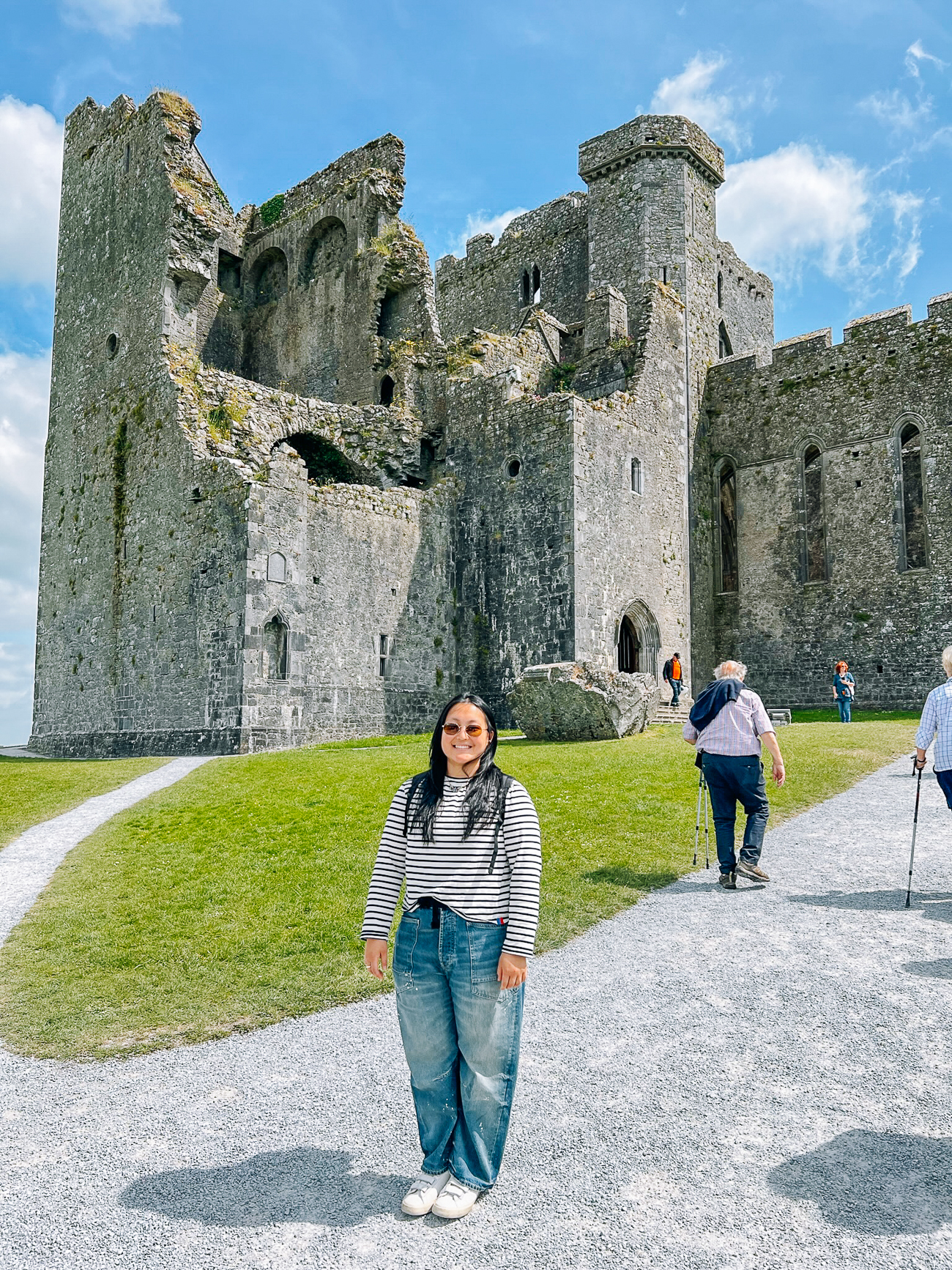



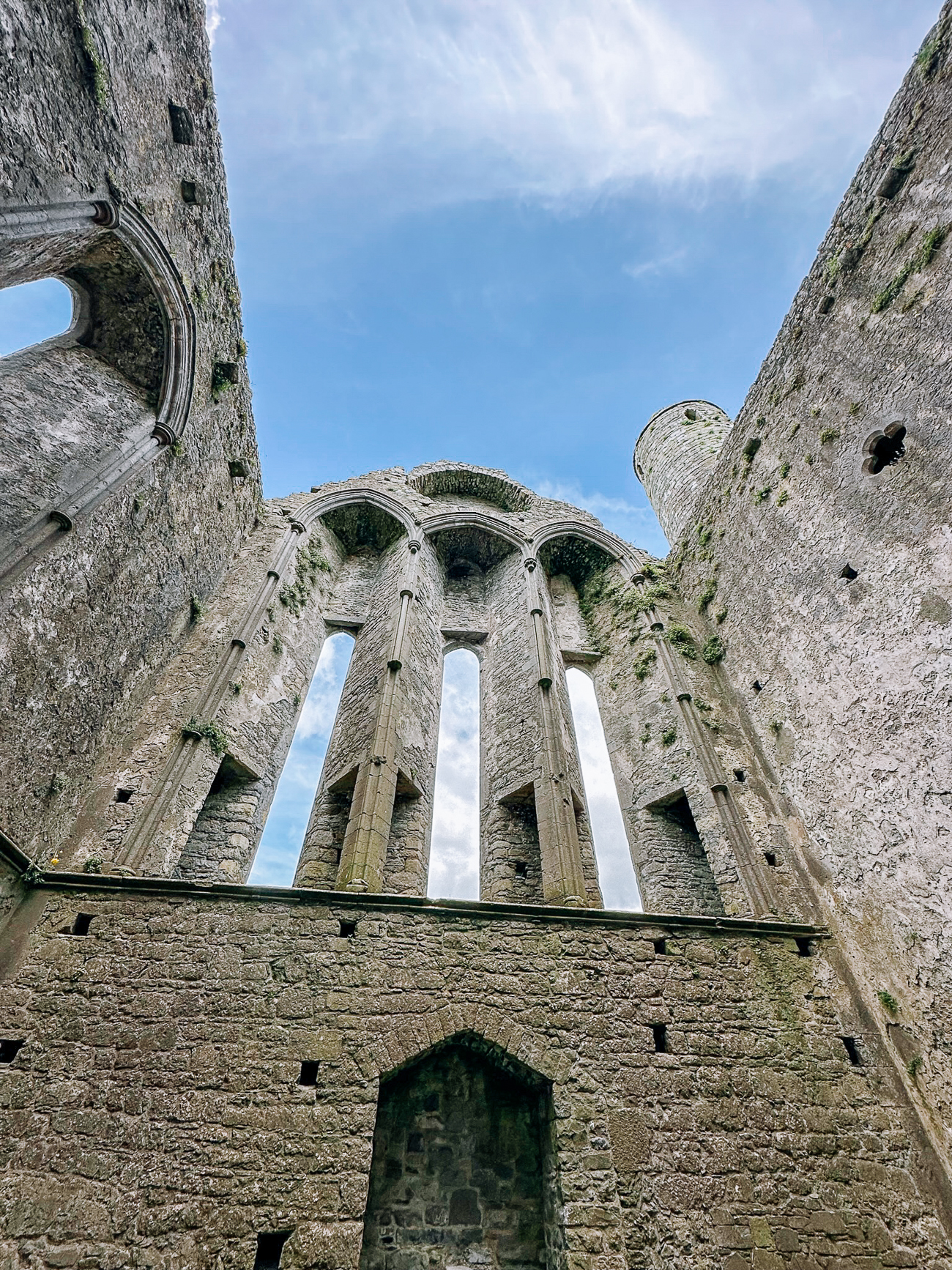
This was the best castle we saw on the entire trip (that’s saying something, as we saw 3 or 4 castles/estates/manor houses).
The tour guides gave a fascinating history of the various phases of the castle: how and when it was defended and conquered, and how it changed over time, weathering the years and different groups who inhabited it.

It was spooky, but fascinating to walk through and think about all the people who had been there before.
If this is the only castle you see, it’ll be time and ticket dollars well spent! My aunt picked up a souvenir “Irish drinking cap” (so much for blending in) and we grabbed a couple of ice cream cones.


The standard is a vanilla soft serve with a rod of chocolate flake pushed into the top. Topical, as a few days before in Dublin, we actually saw a pressing news segment on the declining quality of chocolate flake on our hotel tv!
Kilkenny
Kilkenny Castle
After Rock of Cashel, we tacked on a trip into Kilkenny to explore the castle there.
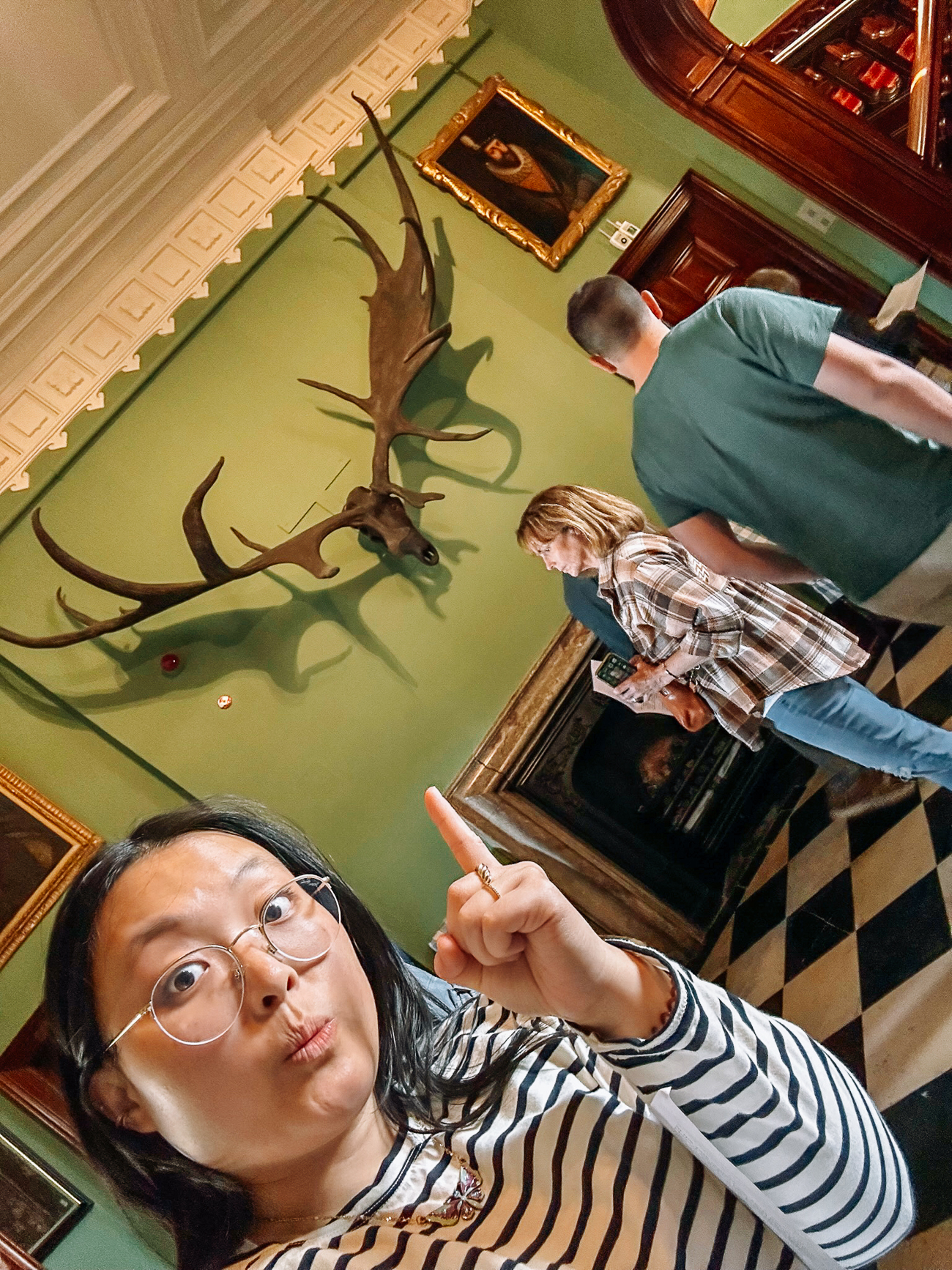






After the major coolness of Rock of Cashel, Kilkenny wasn’t much to write home about. I think if we could have planned it again, we would skip Kilkenny and re-allocate the time elsewhere.

On the bright side, we had dinner at an Asian restaurant that had delicious food and reasonable prices. 4 days is the top end of my limit without rice!

Killarney
After another night in Inistioge we woke up early for a quick breakfast at home to drive to Killarney.


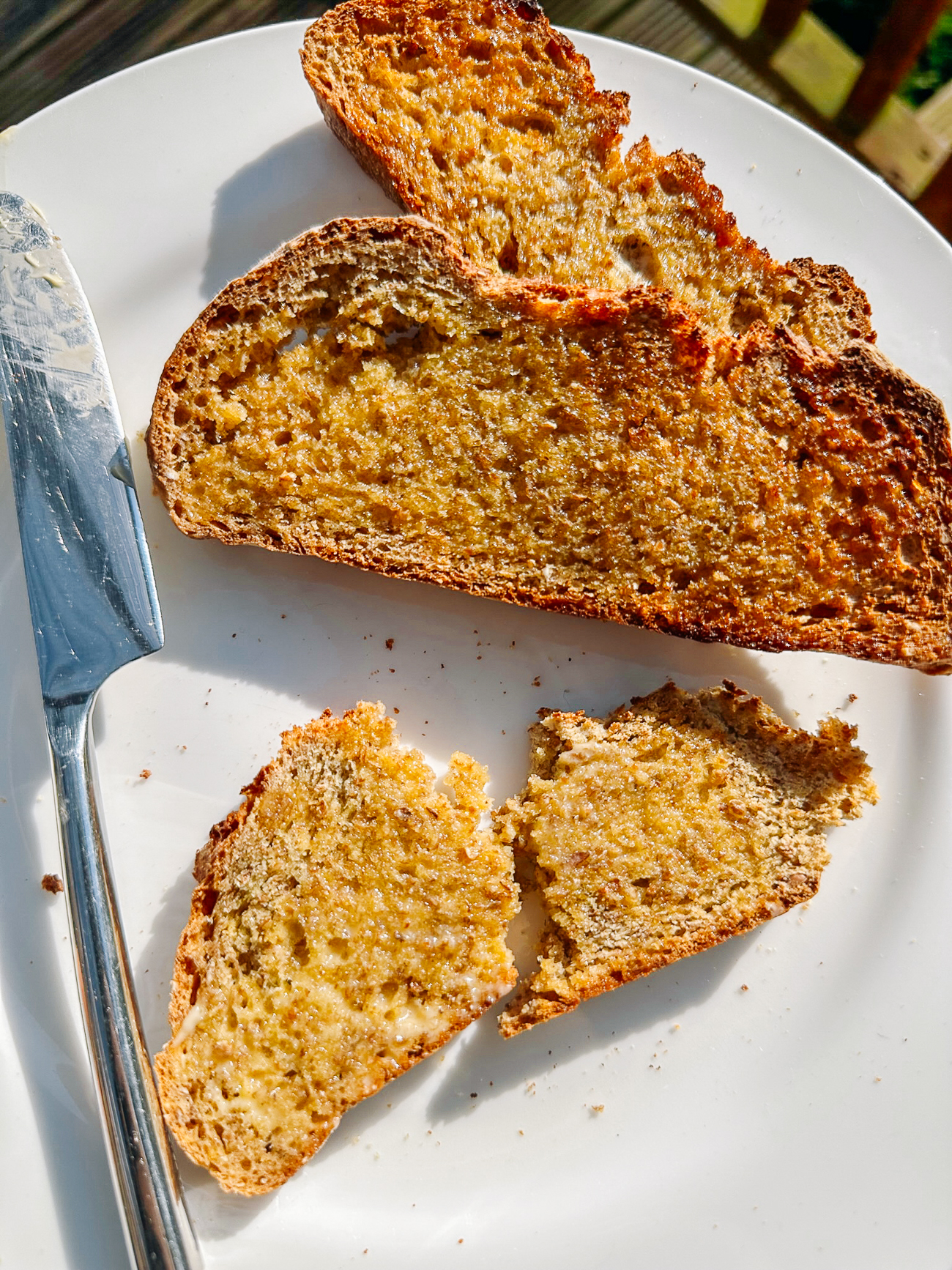

This was one of our longest driving legs at about 5 hours! We broke for lunch during the day in a small town, but otherwise, spent the day admiring the Irish countryside from the car window.
In SuperValu we trust
We loaded up on car snacks and breakfast stuffs to get us through the long car rides and make it easier to head out early every morning. We didn’t buy any raw chickens, but can you believe that price?? 4.49 euro!!!
Note also the Irish Dubliner packaging design.





We also made a good go of sampling the crisp scene and decided that we liked Hunky Dorys prawn cocktail flavor. It doesn’t sound good but it had a lemony tomato tang with a light shrimp flavor. Delicious!

Muckross House
When we finally arrived in Killarney, we had just enough time to check out Muckross House, a home that hosted Queen Victoria and Prince Albert.
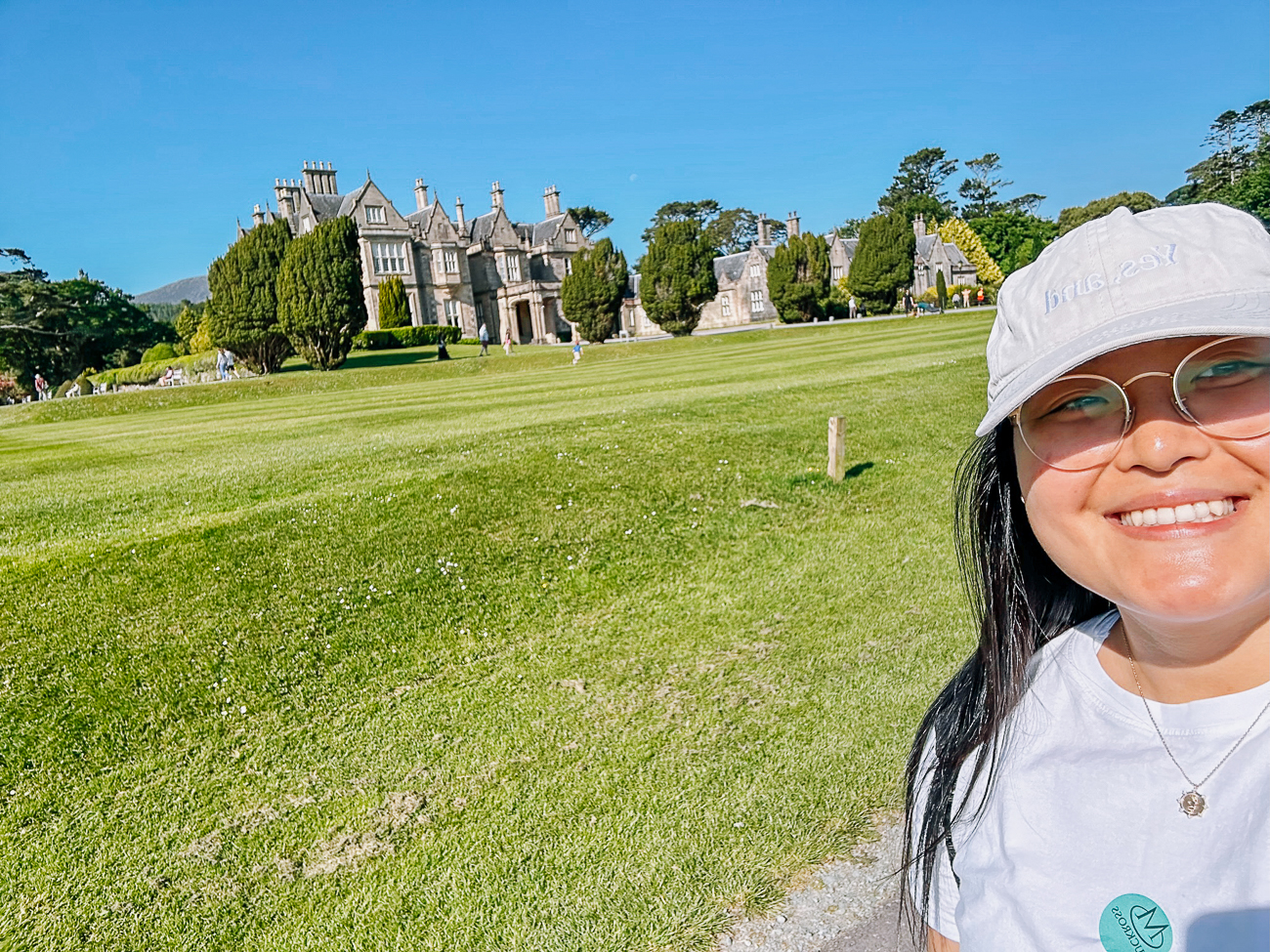
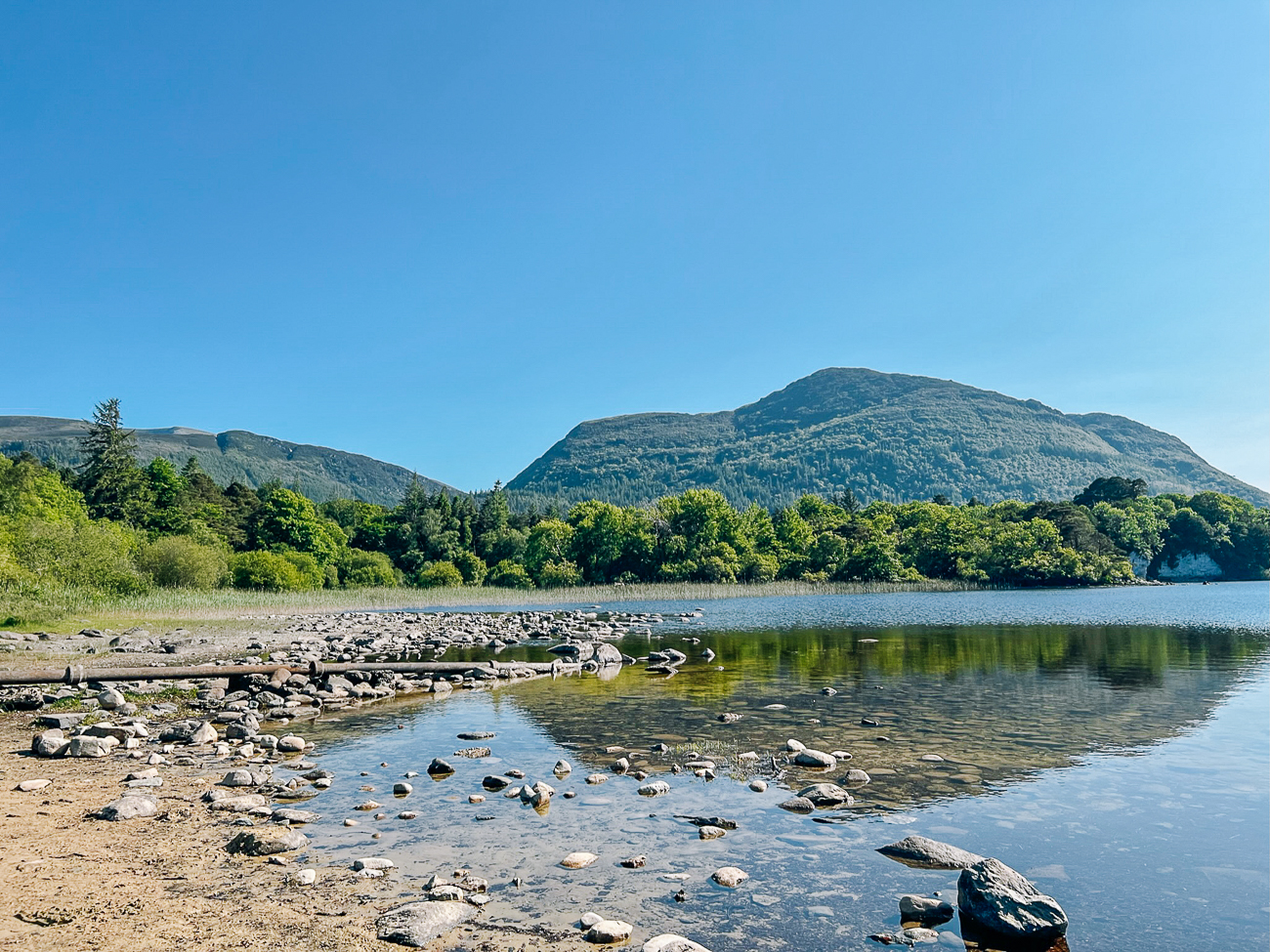

The house was beautiful and set on a shimmering lake with mountains in the distance.








The house was also home to Mucros Weavers, making it an opportune time to pick up some souvenirs.



Killarney and Dingle were not too far apart, so we finished our final leg of driving (about an hour) to get to Dingle, where we would spend a few days.
We had a glorious dinner at Quinn’s Pub of locally caught seafood and watched the sunset on the beach.




We just about went to heaven over this sticky toffee pudding! The mackerel was also some of the best we’ve ever had. The crab linguine was tasty too!
Ring of Kerry bus tour
The next day, we went back to Killarney to see the Ring of Kerry. After all the driving the day before, no one wanted to contend with traversing the narrow roads, so we got a few tickets and boarded one of the tour buses. Our tour guide gave equal parts history, local color, and family anecdotes, pointing out his son’s house and where he got married along the way.
There were a few hokey stops like the Kerry Bog Village that had old school diorama exhibits complete with ancient mannequins. (If you’ve ever seen Gilmore Girls, picture the Stars Hollow museum.)
There was also a stop at a chocolate factory, which was ideal for a quick bathroom break and a few very delicious chocolate samples.
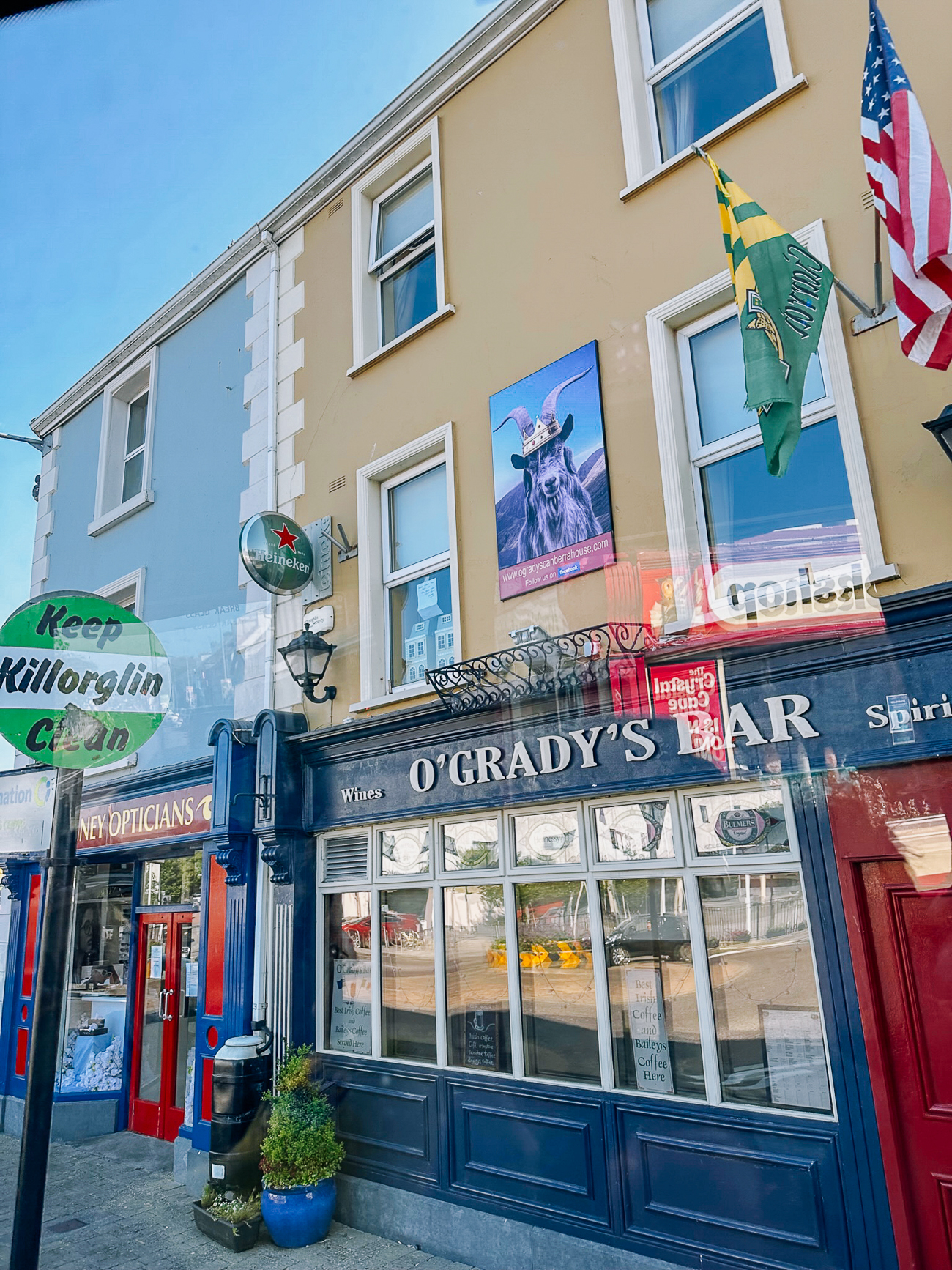




We were also treated to views of the coast with a stop at the beach for lunch, where you could see the Skellig Islands in the distance.





From there, there were plenty of beautiful sights. I started to lose count of the specific names. It was lovely to just enjoy. One of the most famous spots on the Ring of Kerry is the Ladies’ View—a spot deemed particularly beautiful by Queen Victoria and her ladies in waiting.


There was also Torc Waterfall, which featured a short hike through some dreamy Irish woods.

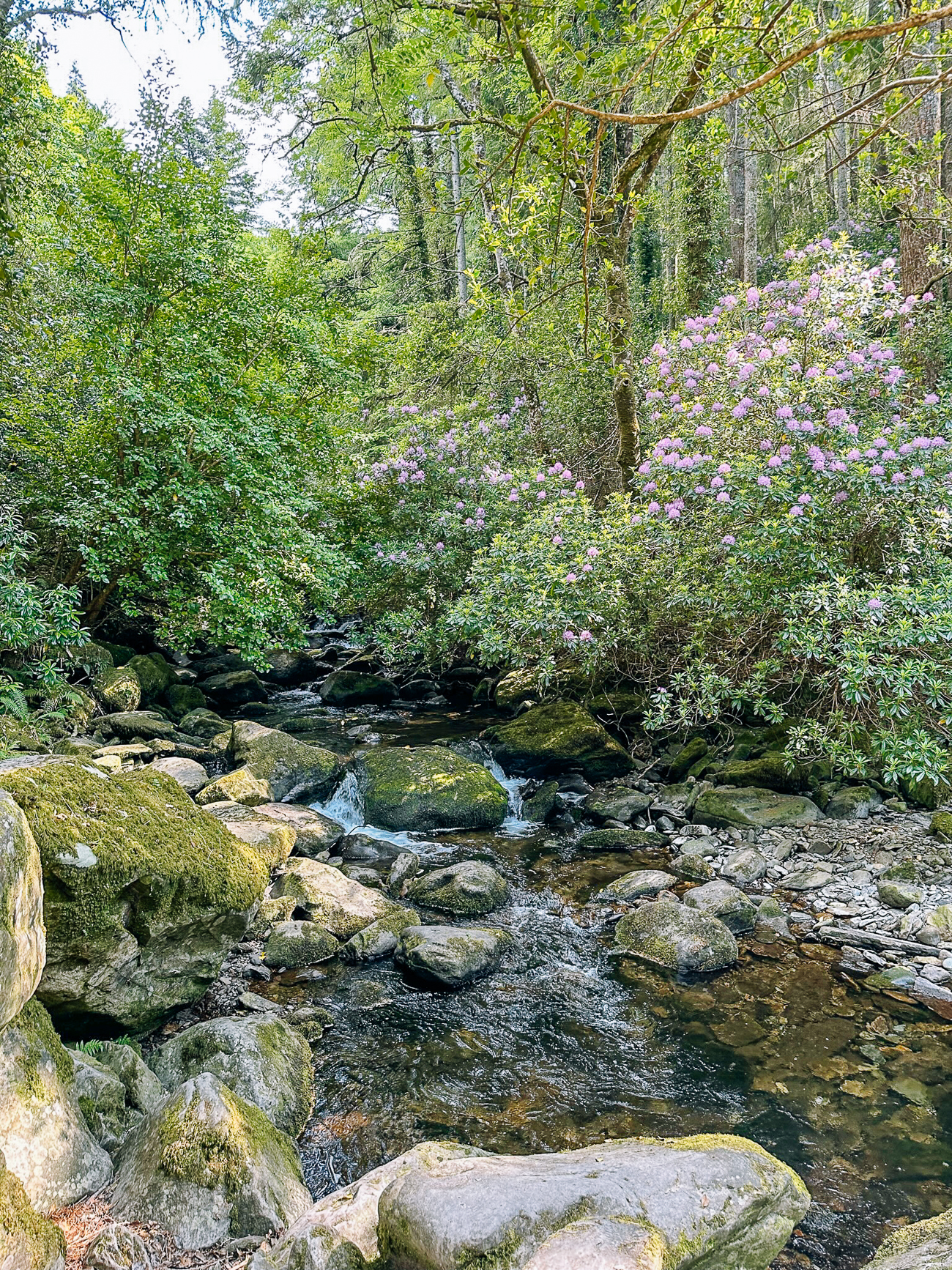
There were some other spots in Killarney that we didn’t have a chance to see, like Ross Castle, Moll’s Gap, Caherdaniel, and Portmagee. We also didn’t have a chance to head through Killarney National Park. You could easily spend a handful of days just exploring Killarney!

After such a long day, we had dinner in Killarney and then headed back to the homestead in Dingle.


Dingle
While Killarney was lovely, we all much preferred the peace and quiet of the Dingle Peninsula. The house we stayed in was quiet and remote, but still close to the town. There was a Supervalu there and lots of very cute boutiques and shops to explore. It was also the place where you boarded wildlife boat tours.


We did a little shopping around the town of Dingle. I purchased Island of Woods by Paul MacMahon, all about the history of Irish woods, how they’ve changed, and how to protect them. It’s a fascinating read, and I would recommend!

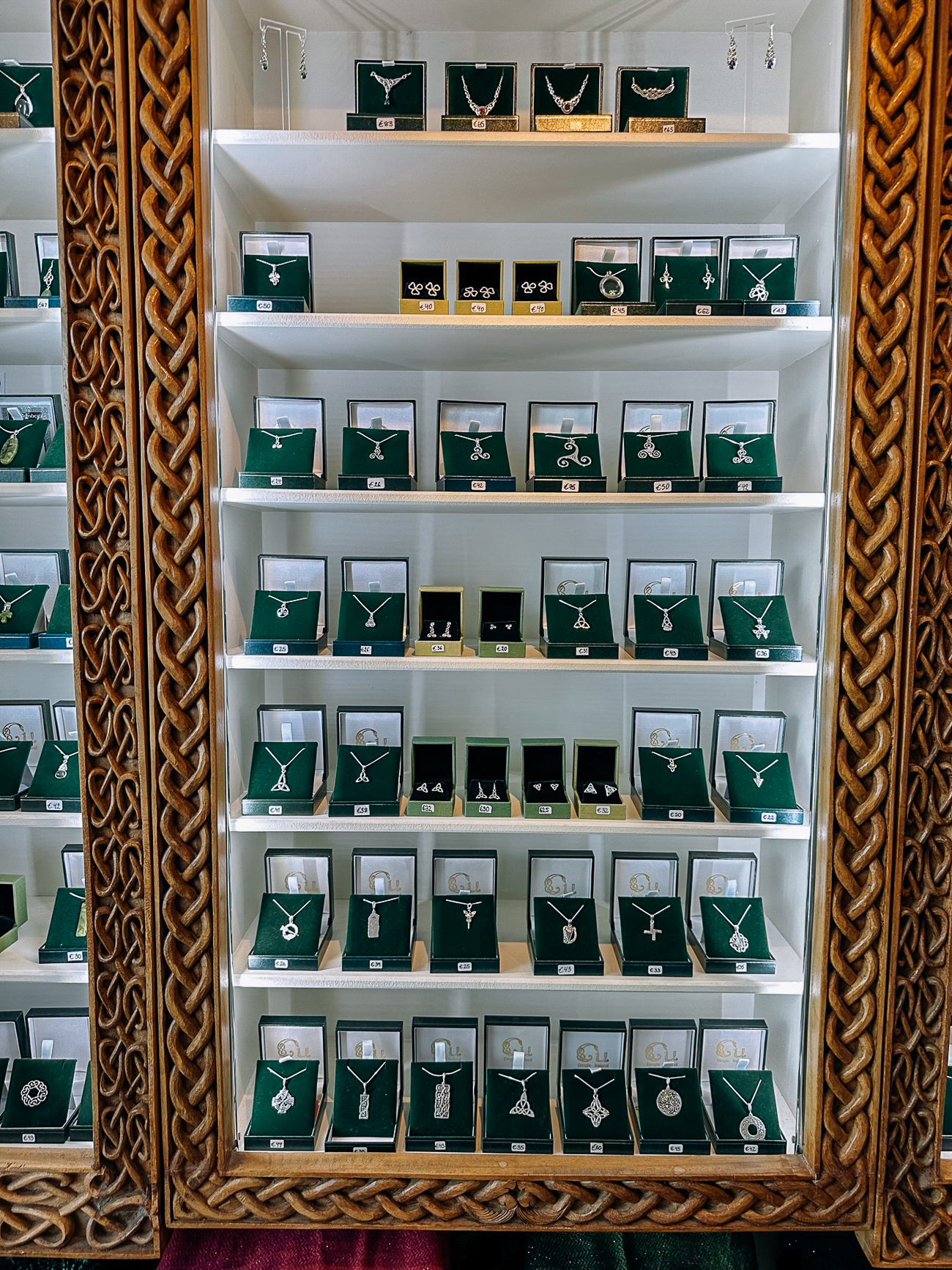
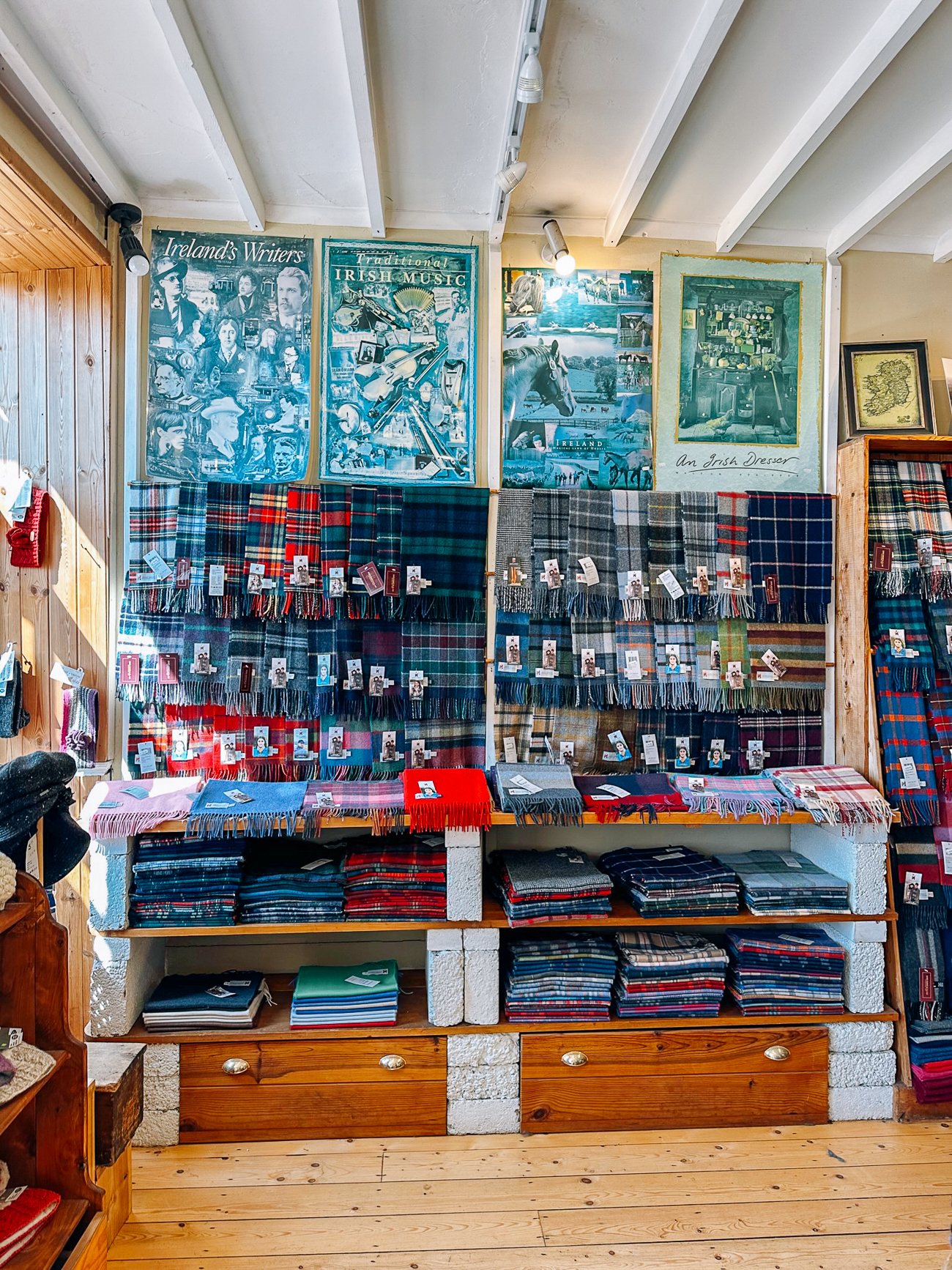


We had a leisurely lunch and then boarded the Dingle Boat Tour to tour the Dingle Peninsula, see dolphins and seals, and get a glimpse of the Blasket islands and Skellig Islands.

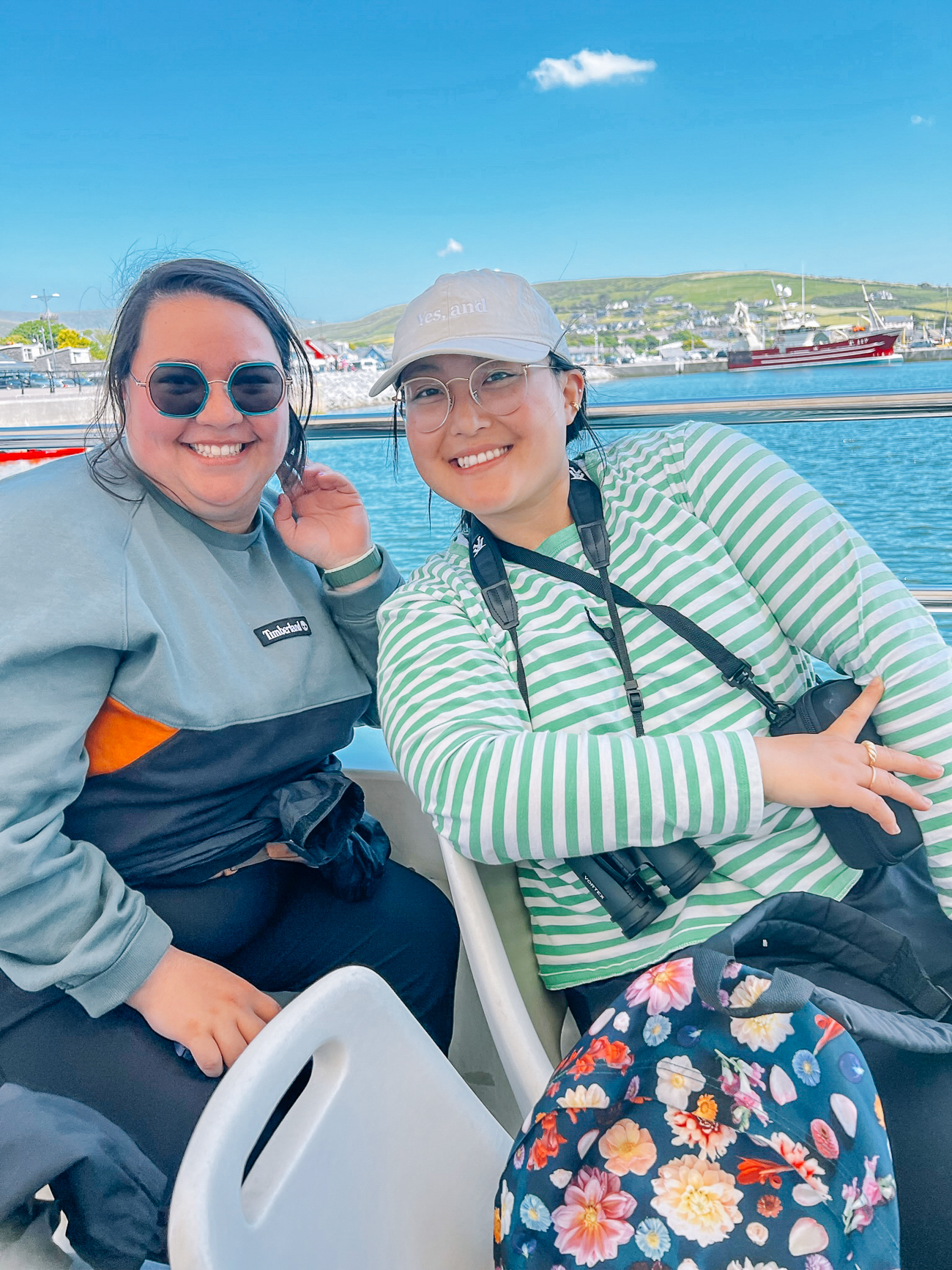
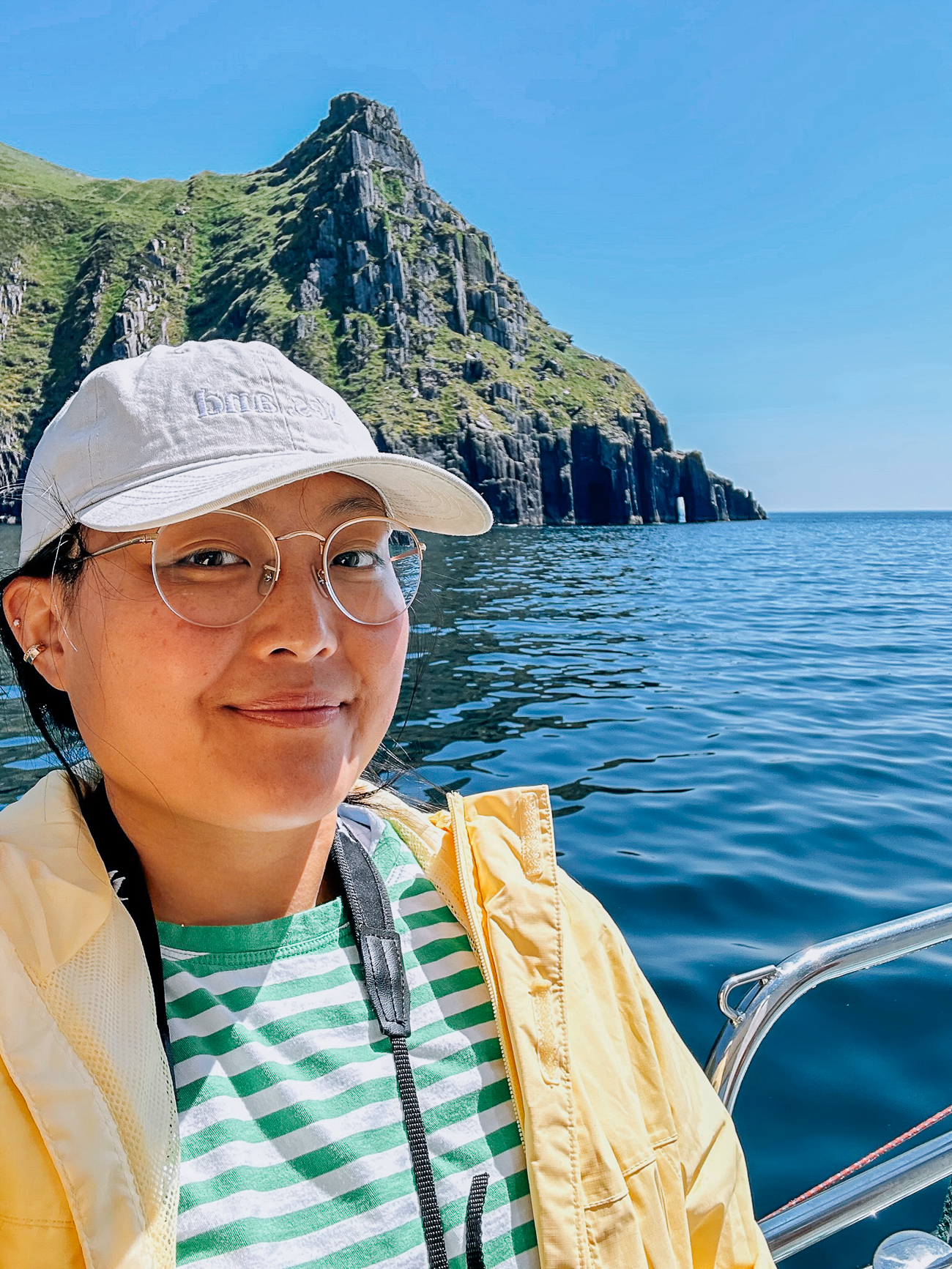

The Blasket Islands were formerly inhabited by just a small handful of folks, now abandoned and reclaimed by nature. The Skellig Islands might look a little familiar, because it’s where they filmed scenes from Star Wars The Force Awakens.
We were more interested in spotting dolphins and seals, though. As nature nerds, it was a real treat and a beautiful way to enjoy the islands and get out of the car for the day! We saw bottlenose dolphins (They’re huge! Peep the mom with the baby, too) and common dolphins.





If you’re familiar with the local lore, a friendly, lone, very large dolphin named Fungie was a local celebrity of Dingle. Sadly, he hasn’t been seen in recent times, but we enjoyed being regaled with tales of Fungie the friendly dolphin and imagining him off on an adventure far from Dingle.
On the shores of the Blasket Islands, we saw a whole mess of seals sunbathing.

You might see that Slea Head Loop is a common scenic drive, but we effectively saw it from the ocean instead of along the road and got a great commentary from the Dingle Boat Tour guide.

I think one of my favorite sights was this sheepdog that was totally at home on this fishing rib boat.


After we got back from the boat tour, we had just enough time for one more dinner at Quinn’s and to enjoy the sunset on the beach.








Cliffs of Moher (near Galway)
Everyone was sad to leave the serenity of Dingle to head towards Galway and the Cliffs of Moher.

The Cliffs of Moher is one of those stunning vistas that you may have seen in tv shows and movies. (I watched Leap Year after coming back from this trip, and hilariously, the movie takes place largely in Dingle, but the happy couple steps out of a pub in Dingle and is magically transported hours north to the Cliffs of Moher for the climactic proposal scene.)
There are some fairly easy walking paths along the cliffs where you can enjoy the scenery and see the seabirds flying down below. That’s how vast the cliffs are! The hardest part of the walk is that it was in full sun with no tree cover.
There’s also a museum where you can read about the cliffs. Admission is included in the price for parking.
I’ll let the scenery speak for itself! I also thoroughly enjoyed birdwatching as puffins nest on the cliffs of the cliffs. It was hard to see with the grade of binoculars I had, but I could just make out the bright orange feet and little black bodies of the puffins!




We opted to pack sandwiches and snacks for this day, because while the cliffs had a cafe, it was crowded and didn’t have many options. We were glad we had stocked up on groceries in the Dingle Supervalu for a picnic lunch instead.

Poulnabrone dolmen
On the way to Athenry to bunk down for the night in a hotel, we stopped by Poulnabrone dolmen, one of the largest and the oldest Irish megalithic portal tombs in County Carlow.


If you’ve ever visited (or wanted to visit) Stonehenge, Ireland seems to have an astounding number of these structures that actually predate Stonehenge and are very well-preserved.
Brú na Bóinne
The next day, we continued our tour of ancient sites and headed to Brú na Bóinne. It’s a UNESCO world heritage site! It is a vast neolithic structure that was built 3,000 years before the Egyptian pyramids and 1,000 years before Stonehenge. That brings it to over 5,000 years old.
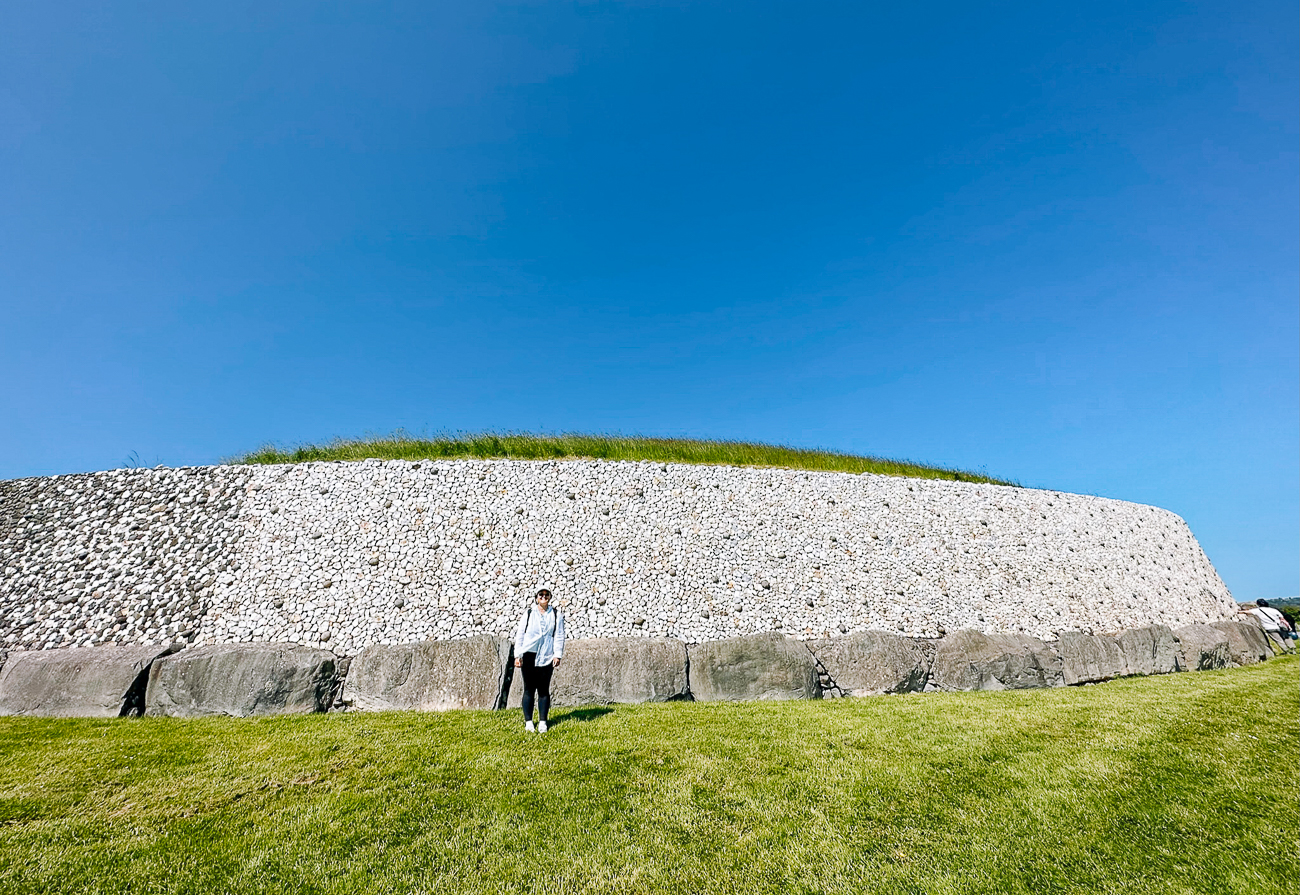
There was a very informative tour and a detailed exhibit on the excavation process and how researchers believe Bru na Boinne was used through the years.


From the museum, you walk a short way to board a bus, which takes you to the burial mounds. There you meet with your tour guide. You start at Knowth, which is a cluster of smaller burial grounds.







Then head to Newgrange, which is one vast burial mound with an inner ceremonial chamber that was built to line up with the winter solstice, which means the light shines into the entryway, perfectly illuminating the chamber.


Of course, you weren’t permitted to take pictures inside the chamber, but they were able to turn off the lights inside, giving a sense of what it would look like if you were walking into the chamber in ancient times.
It was a very special and fascinating experience and was definitely one of the highlights of the trip!

Finally, we headed back towards Dublin to get on a plane the next morning.
Other spots to consider
Another small stop we made was Dunguaire Castle. It was a minor castle on our route, but you could easily skip it if needed.



While we skipped Cork and Waterford, I do think that those would be fun spots to check out on a future trip.
We did it to avoid being rushed in Killarney and Dingle, which paid off in spades since we really enjoyed both of those areas. Cork is a bit of a foodie town. There you’ll find the Ballymaloe Cookery School, organic farms and gardens (a few weeks later, I binge-watched Rachel Allen’s cooking show). And Waterford is known for its crystal production.
We also originally had Blarney Castle on our list. It’s where people flock to kiss the Blarney Stone and get the “gift of gab,” not too far outside of Cork. But after reading an admittedly scathing review of Blarney Castle in my aunt’s Rick Steves’ travel guide, we decided to skip it to take some heat off the driving timeline. Blarney is also where you can visit Blarney Woollen Mills.
Some other areas that I would be curious to visit are Donegal and the Aran Islands. We never went further north than the Galway area, and that was really just to explore the Cliffs of Moher.
Some other adjustments that we could have made: simply skipping Kilkenny Castle, perhaps in favor of Malahide Castle earlier in the trip (it’s outside of Dublin) or just less rushing in general.


I’m already thinking about a trip back to Dingle or the Wicklow Mountains to savor the mountains and the seaside. Another observation is that if you’re looking for a nice resort-ish area to hunker down in style and play golf, Killarney seems to be the place to do it!
The Best Food in Ireland
This section isn’t so much about “must try” restaurants, which could lead down a wild goose chase that can take the spontaneity out of travel. Rather, it’s a starting point with a guideline on how to approach the food you’ll find in this good green country.
First things first, the food in Ireland doesn’t inspire much in the popular imagination, but that may be unfair.
Before the trip (while on our west coast book tour) I purchased a copy of The Irish Cookbook by JP McMahon. He chronicles a wide range of simple Irish recipes and also its evolution relative to agricultural practices and changing social landscapes. I found it to be a fascinating read that helped me get in the spirit and know a bit more of what to expect before the trip!
Irish food is very simple as a general rule. The less kind (though sometimes truthful) way of saying it is, it’s not that flavorful. But we really didn’t have any extremely terrible meals, just a couple that were not that great (one was a bit of a tourist trap on our bus tour, and the other was at the Dublin airport—no surprises there).
My theory is that it’s one of those countries where the locals won’t tolerate a place slinging bad food for long, no matter the price.





In the spirit of learning the lay of the land rather than the star-rated restaurant game, it’s worth mentioning a handful of standout Irish foods that I savored and still remember fondly:
- Lamb is plentiful and expertly prepared. You can also see that just about all the lamb seems to be lovingly raised.
- Potatoes, of course, are served with just about every meal. (“Vegetables” entail carrots and parsnips, so get your greens when you can!)
- Irish chips may well be better than English chips across the board (and by chips I mean fries.)
- Guinness beef stew is absolutely worth a try.
- …But lamb stew, made with a simple golden lamb stock and root veg is the real prize.
- If you’re in a seaside town, have the locally caught seafood every chance you get.
- Brown Irish soda bread made with Irish-style wholemeal flour (i.e., coarsely ground, super soft flour that still has bits of the bran, endosperm, and germ from wheat) is *exceeeeptional*.
- Salty, golden Irish butter is required in copious amounts. I bought a resealable container of the stuff and toted it around. (It was smuggled into a hotel breakfast bar—send those generic hotel butter pats packing!)
- Irish cheeses are delicious. The ones we sampled seemed delicate and mild largely. Definitely worth gathering some samples at a cheese shop or grocery store. There was a cheese shop in Dingle, but alas! They had to close early for the day when I wandered by.
- Skip the corned beef, which was perfected and injected with loads more flavor by Jewish folks on the shores of America.
- Ham is simply better in Ireland. Lightly flavored so it has a pure, lightly salted ham flavor and less briney texture, because Irish ham is soaked to get rid of excess salt and cooked from a raw state. Have a toastie or a hot slice with mashed potatoes. I wish I had had more ham. That is all.
Now that you know what to look for, here are the restaurants we went to or wish we had been able to snag seats at:
Davy Byrnes (Dublin) – Made famous for being a James Joyce haunt that made it into his writings. Their lamb stew is delicious and perfect, and they had a handful of delicious starters like steamed mussels and cod fritters. A touristy choice, but worth the stomach room.


ABout that lamb stew…
…We don’t have a recipe for it. (Yet!)
But! We have gotten a slew of inquiries about it since posting, so I’m putting an update here:
I would say the unique thing about this Davy Byrnes recipe is that it tastes like the lamb was stewed for a long time but the potatoes and carrots weren’t. It was very fresh tasting. My guess is they would have made a lamb stock first and then simmered the lamb chunks and broth with carrots and potato JUST long enough to cook them and serve. So it’s like a soup / stew hybrid. That’s my hunch on what made it very golden and brothy. When you first ate the stew it was brothy, as you got to the bottom of the dish it turned more starchy.
This recipe from Donal Skehan looks pretty good as well! He does mention that a trick is to use lamb flavored bouillon or “Bisto” granules which is a brand of instant gravy for extra tasty stew. https://youtu.be/rB41QE672dc
This less detailed recipe video from O’Reilly’s Recipes also looks great and much closer to the Davy Byrnes stew, and it confirms my lamb stock hunch! Sadly no details are provided on just how he made the lamb stock! In a restaurant setting my hunch is that they may just be leaning on lamb bouillon… https://www.youtube.com/watch?v=ExZ7MbI6O5Y&ab_channel=OReillysRecipes
Hope that helps and gives you somewhere to start with recipe tinkering!
Gallagher’s Boxty House (Dublin) – Little did I know when booking that this restaurant was featured on the Dublin episode of Somebody Feed Phil. It makes sense given that the reservations were almost fully booked out three months in advance for prime dinner seatings. The boxty sampler platter was fun to try, but don’t feel too bad if you don’t make it to this spot.


Bewley’s Grafton Street (Dublin) – While New York is the city that never sleeps, Dublin seems to be a city that is content to sleep in. Most everything on the weekends opens at 9am, and it’s pretty tough to find places that are open before 8:30am. Happily, timing worked out for a delicious and filling full Irish breakfast at Bewley’s Grafton Street, which opens at 8:30am on Saturdays. Their morning buns are yeasty and delicious if you like that sort of thing. (And I do.) Their scones are also probably some of the best we had—in Ireland. That said, best to save your scone allotments for England or baking at home.




Powerscourt House & Gardens Cafe (Enniskerry) – We got lost in the Powerscourt gardens. Luckily, there is a cafe on premises. The house has actually been converted into retail shops with clothing, trinkets, and souvenirs, and a cafe that has vibrant salads, decadent quiches, sandwiches, and warm entrees.
Wicklow Heather Restaurant (Wicklow) – A godsend of a place that we stumbled upon after briefly and troublingly reading that in the countryside, you might be out of a meal past 7:30 or 8pm. This place stays open on the later side and had the best slice of soda bread of the trip, some delicious chowder, and a wickedly tender lamb rump roast along with a bunch of other tasty entrees that everyone was really happy with.




O’Callaghan’s Delicatessen & Cafe (Mitchelstown) – A nice stop on our driving route from Inistioge near the Wicklow Mountains to Dingle and Killarney. They had a perfectly portioned kids menu of classics and a selection of delicious salads. I had a great broccoli, feta, and roasted candied hazelnut salad and curried couscous with my children’s portion of chicken goujons (i.e., chicken fingers), mushy peas, and chips.


Aroi Asian Fusion (Kilkenny) – On just about every international trip I go on that isn’t China itself, I get a potent craving for a heaping pile of vegetables and rice. This hit the spot with an assortment of largely Thai and Malaysian dishes.
Out of the Blue (Dingle) – A well-known spot for seafood that was on our list to try, as they have a changing menu based on the local catch. We were foiled by a tourists’ over-reliance on Google, however. A handwritten sign outside said to pop by for lunch 11-4pm at their discretion, whereas Google reported their being closed entirely. Alas! Next time.


The Strand House (Dingle) – A nice spot for lunch if you’ve got seafood averse folks in tow or are looking for a good salad, toastie, baked good, and cup of tea.



Quinn’s Pub (Ventry, Dingle peninsula) – A must if you’re in Dingle for unpretentious, deliciously-prepared local seafood. We ate there every night during our stay in Dingle—three times!




Are there Chinese restaurants in Ireland?
The Chinese diaspora knows no bounds! During our trip, I kept an informal log of Chinese restaurants in every town we drove through. There was one in over half of the little towns we drove through.
It was a pleasant surprise and a funny reassurance about how much love there is for Chinese food around the world. The second most common non-Irish sight was Indian restaurants, but nowhere near as commonly found as in the U.K., unsurprisingly.
Funnily enough, the Chinese restaurants seemed more frozen in time, with simple, vegetable-light fare that was heavy on thick sauces and fried items—what you might expect of super retro Chinese American takeout spots.
Where to stay
During our time in Ireland, we tended toward Vrbo’s, as we were a large group and they were more economical. Oftentimes, prices on Vrbo are cheaper than Airbnb, with some hosts having double listings on both sites, so be sure to check both.


You’ll also want to book well in advance to get the best accommodations. Consider looking a year in advance! That said, there were numerous boutique hotels on our trip that had decent availability. Larger chains were in Dublin, mainly.
Be on the lookout for early check-in deadlines. Two of our hotels required check in by 7:00PM, and if you missed it, you were out for the night. Hard to say how strictly enforced it is, but they don’t seem to be joking around on this front, so do your best not to find out!
For some reason, washcloths don’t really seem to be a thing in hotels, so you may want to bring your own.
Getting around Ireland
Renting a car
Renting a car is a must in Ireland. Trains and buses simply aren’t convenient for most or don’t provide the flexibility you’ll want if you’re trying to cover a lot of ground.
We did do a one day bus tour around the Ring of Kerry because our designated drivers wanted to enjoy the scenery rather than get spooked over the high altitudes and narrow roads. But I discovered Ireland is best savored, and having a time limit from a roving bus tour was a bit of a killjoy.
We got our cars at the Dublin airport. Technically speaking, taxis are not allowed to bring you to the rental car complex, but we got lucky with a friendly taxi driver who bent the rules for us. If you’re renting as soon as you get off the plane, you’ll take a shuttle there.
Of course, the elephant in the room is driving on the opposite side of the road. Our taxi driver was an older fellow named Liam. He happily took it upon himself to teach us how to drive and walk us through the route as he drove, explaining the lines / markings and formal and informal rules of the road (there are no yellow divider lines!)

Navigating one lane roads
Two-way roads are a bit of an illusion in Ireland. People may drive on them in both directions, but they’re basically the width of a single lane with periodic gravelly pullouts that are just big enough to let the car opposite you pass.
Basically, whoever is closest to a pullout pulls over, and if it’s a toss up, both cars slow down and hug their side of the road as best they can to avoid any mishaps.
Irish people are polite and friendly. If you do have any close calls, it’s best to stop and see if the other car is alright before proceeding. It’s not like driving in New York and New Jersey where the liberal “no-harm, no-foul, ok-then-get-on-with-your-life” policy reigns.
You’ll hit tolls, and you’ll be able to pay with either cash or tap a card for contactless payment. It’s super convenient. For the M50 back to Dublin airport, you’ll need to purchase toll passes for each of your cars. You can buy these at a gas station or on the eFlow app.

To uber or not to uber?
In Ireland, Uber seems to be simply a channel for hailing a taxi. As a result, an extra 5 euros or so gets tacked onto your fare, so it’s definitely better to hail a taxi if you can.
Walking
The most walking we did was in Dublin, but it is a hilly city with cobblestone streets at some places, so it’s not terribly convenient or enjoyable if you’re traveling with less mobile folks.
Given that we were with the so-called Old Biddies, we actually opted into a hop-on, hop-off bus tour to get both some insight into the city and free transportation between key sites.

How to save travel time in Ireland
For some reason, the Google Maps algorithms don’t seem to have a good handle on Irish travel routes. Walking directions tended to take a lot longer, or at least feel much longer, and driving directions took 1.5 or 2x the amount of time because of the windy roads.
After a while, we started plotting our routes along major highways only, technically tacking on time, but ensuring a safer and more pleasant driving experience. M motorways are the widest roads, N is next, and R is after that. Local roasts marked “L” are quite narrow.
From the Wikipedia:
The different classes of roads in Ireland are allocated blocks of numbers so that no number is used more than once save in the case of Local Primary Roads.(not all road numbers are currently in use):
- National Primary Roads are numbered from N1 to N50 (motorway sections are signed with M prefix instead of N ).
- National Secondary Roads are numbered from N51 to N99.
- Regional Roads are numbered from R100 to R999.
- Local Primary Roads are numbered from L1000 to L4999.
- Local Secondary Roads are numbered from L5000 to L8999.
- Local Tertiary Roads are numbered from L10001 to L89999 with the first 4 digits representing the Local Primary or Secondary road it starts off from. Local Tertiary roads which are unrelated to a Local Primary or Secondary road are given numbers from L90000 up.
What to pack
Here are a few things to know.
- Normally there is rain. Copious amounts the way the locals talk about it. We got lucky and a very uncharacteristically early and warm and dry entree to summer.
- There is no AC! The way to cool the room is to open a window. There are also no window screens, but somehow, they seem to have very few bugs and flies around. You can also ask hotel reception if they can provide a fan, which they usually do have.
- Bring a swimsuit and some sandals regardless of what you may think.
If you’re like me—i.e., a gal prone to flights of fancy and visions of romantic rolling hills, dramatic cliffsides, and moody yet beautiful skies… In short, we were expecting this.
“Rain!” we said!
“Clouds, please!” we said.
“Moody skies to wallow in besotted misery like tragic Irish heroines!” we said!
Instead of a sad girl spring to play out any delusions of Outlander chic, we got clear, cloudless blue skies, persistent sunshine, warm weather (and sweaty days) all the way from Dublin to Dingle to Galway and back.

So here are my packing tips:
Pack a light windbreaker and/or rain shell. I had a rain jacket that was too muggy for the heat of day, but ideal for our time on the Dingle Peninsula, where we went on a boat tour and caught the chilly spray of the North Atlantic. Don’t bother with an umbrella. It’ll just blow around and weigh you down.
The rest of the time, I wore a cropped windbreaker that did double duty on keeping the morning and evening chill away and protecting me from the sun when my tan from walking around and sitting in the front seat of the car started to veer into sunburn.
Definitely bring a swimsuit if you’re going to be by the coast!
Conclusion
We hope you enjoyed this tour of Ireland and that it helps you plan a trip if you’ve got one coming up! :)





